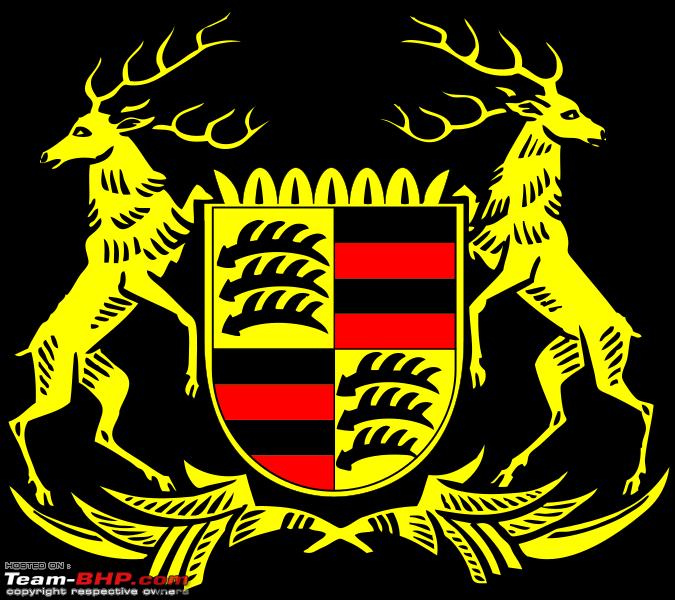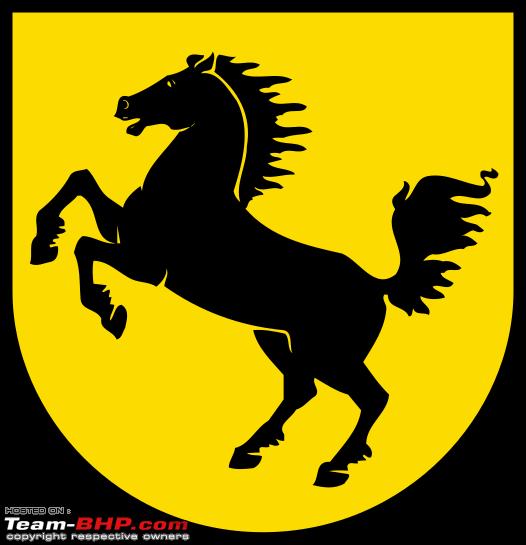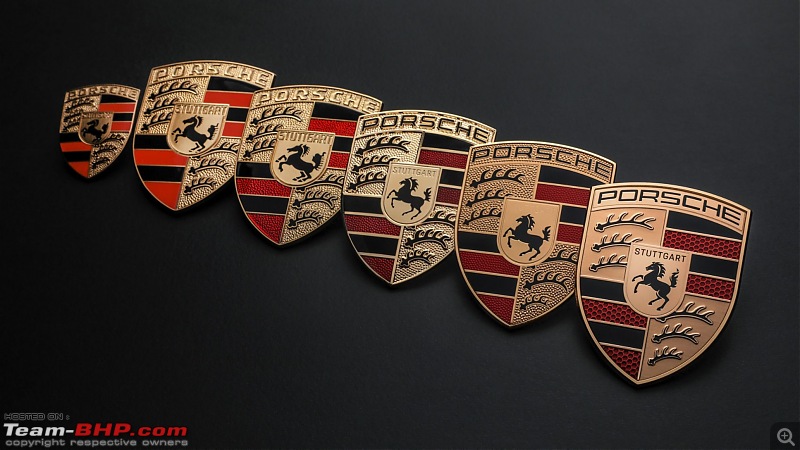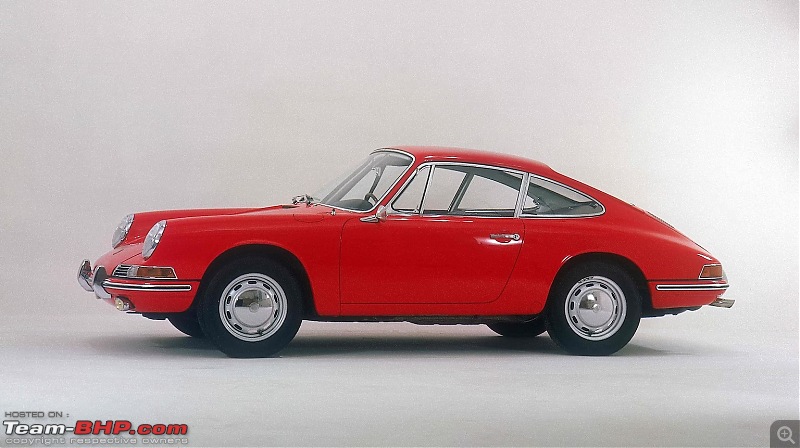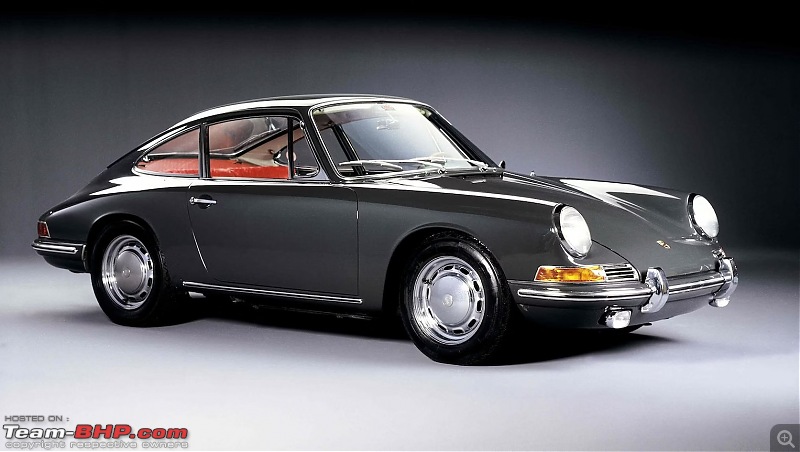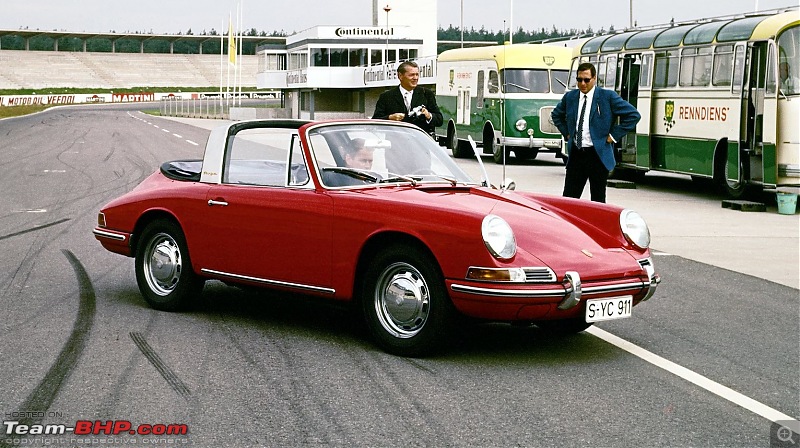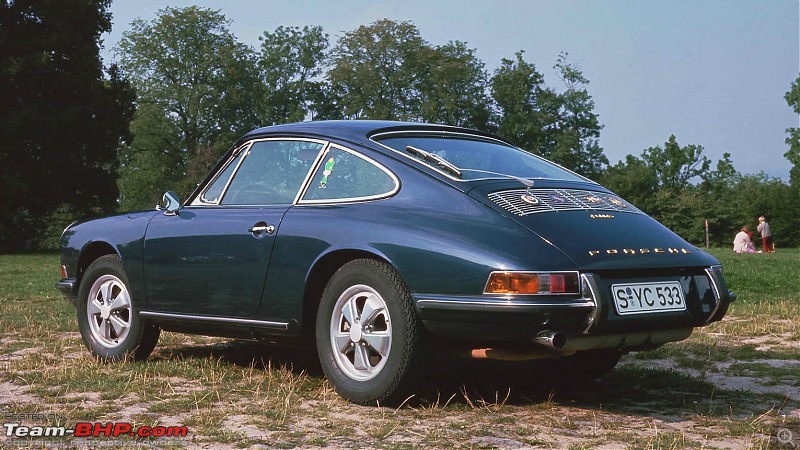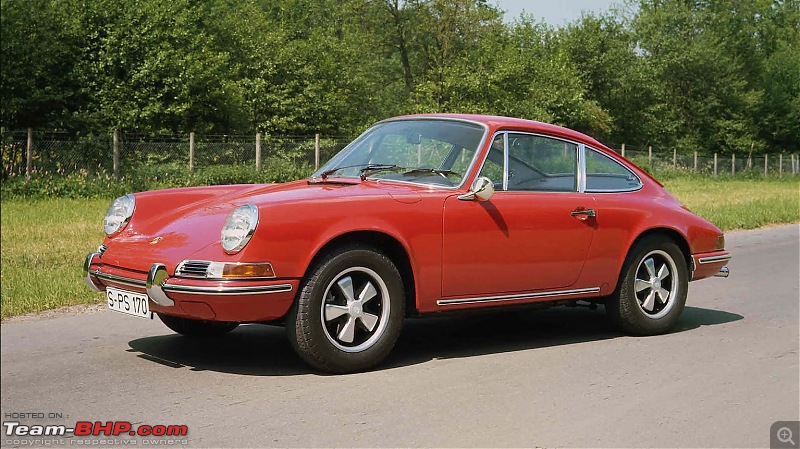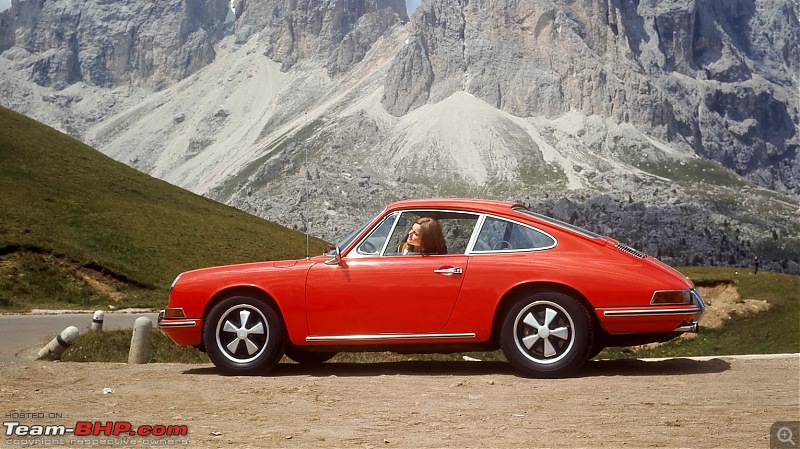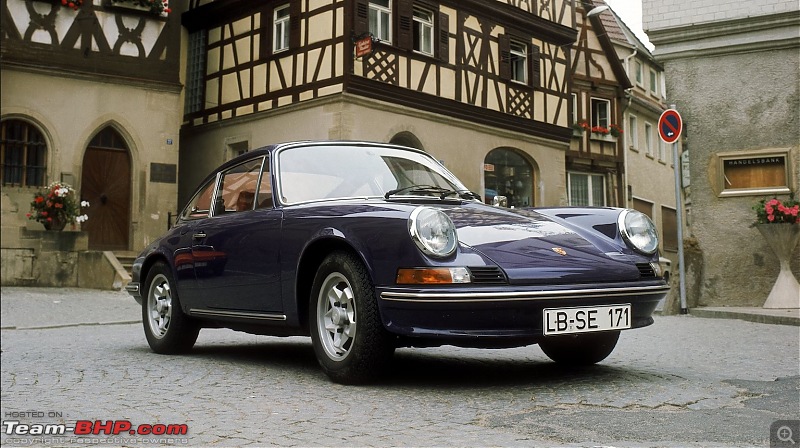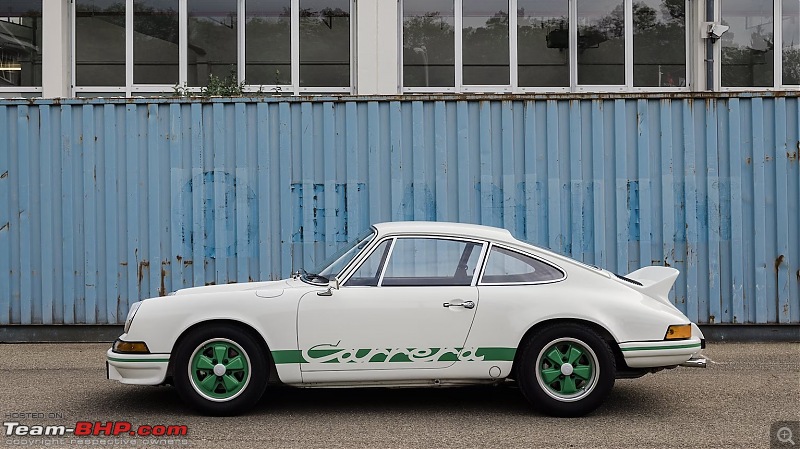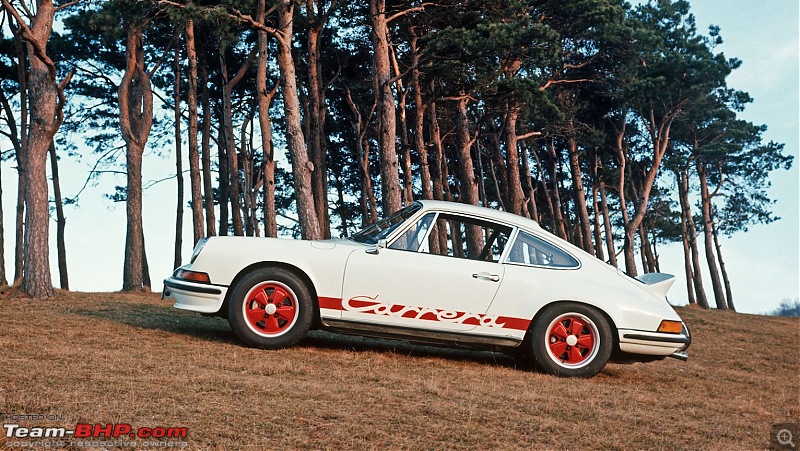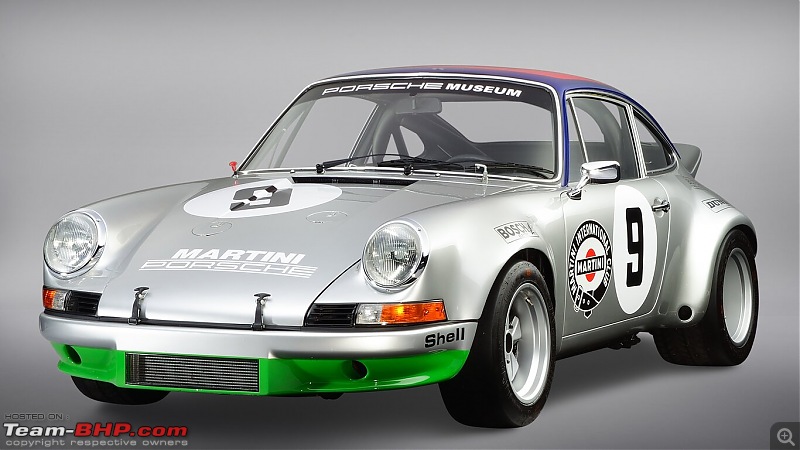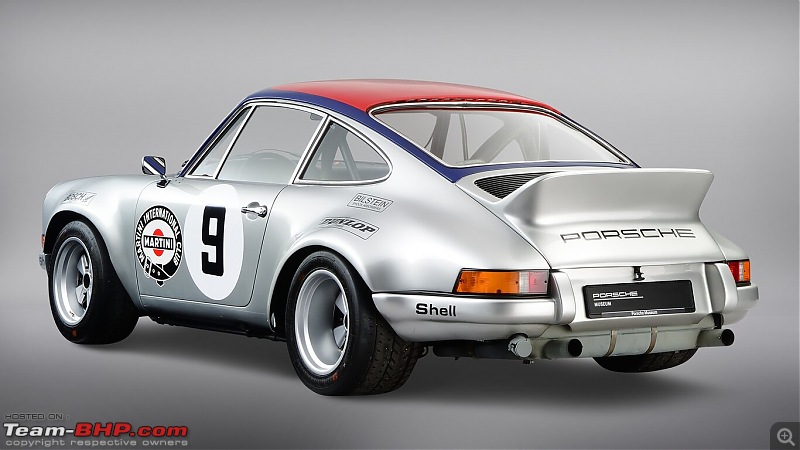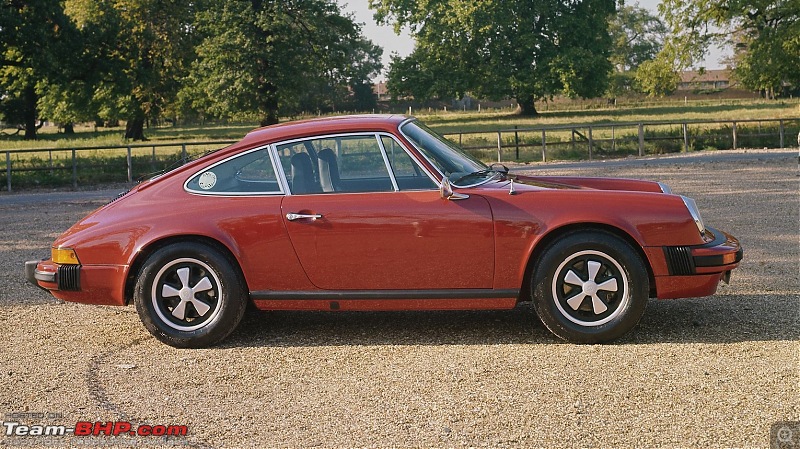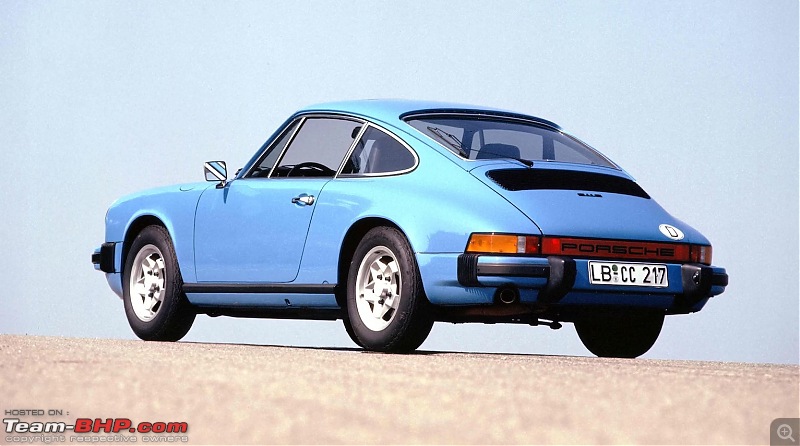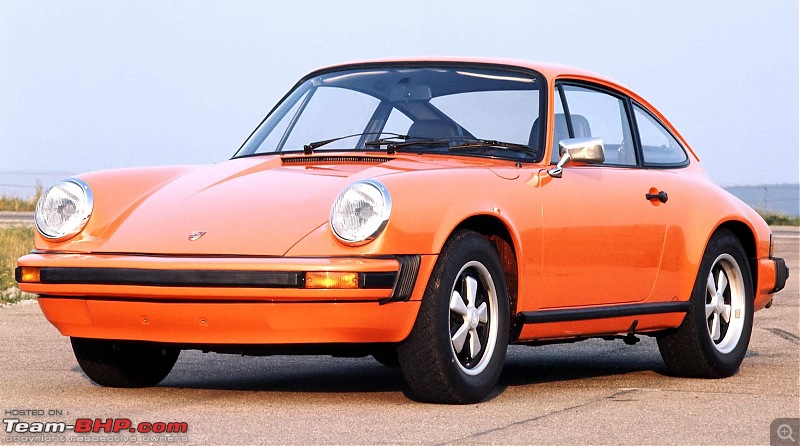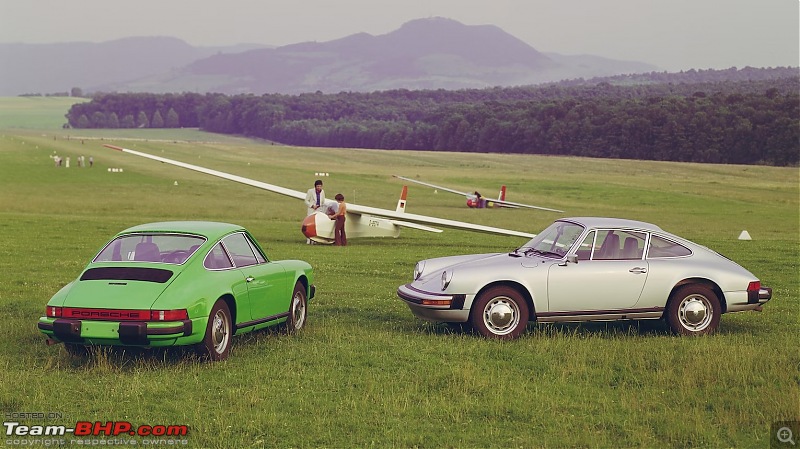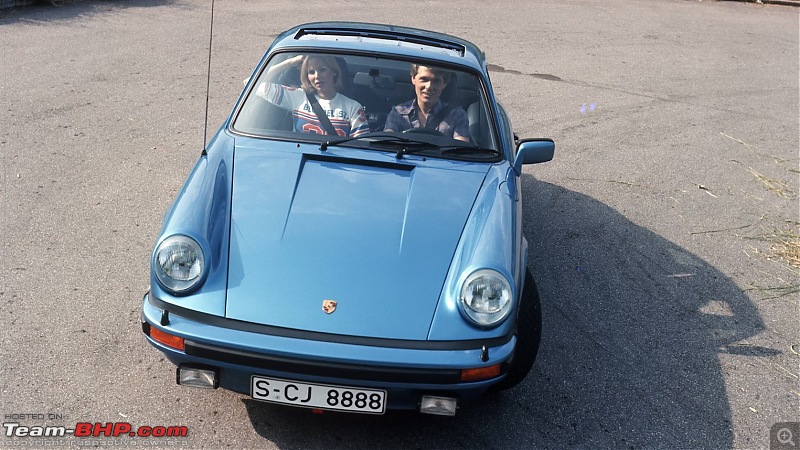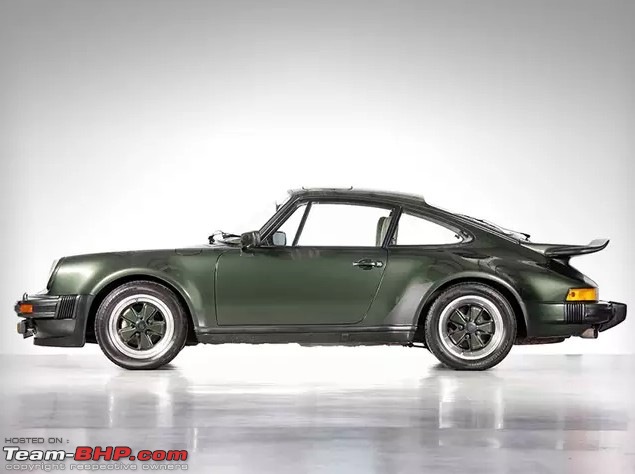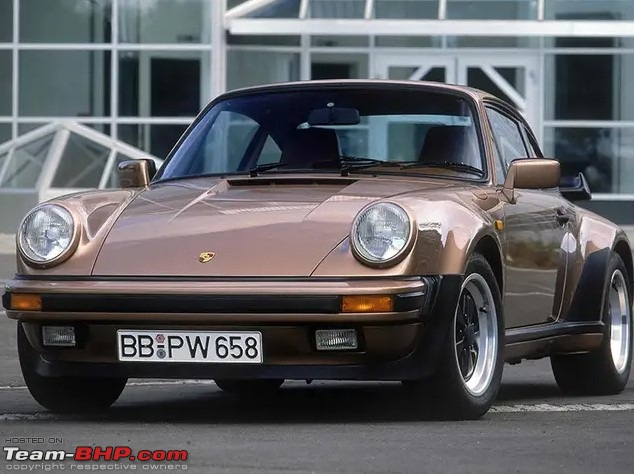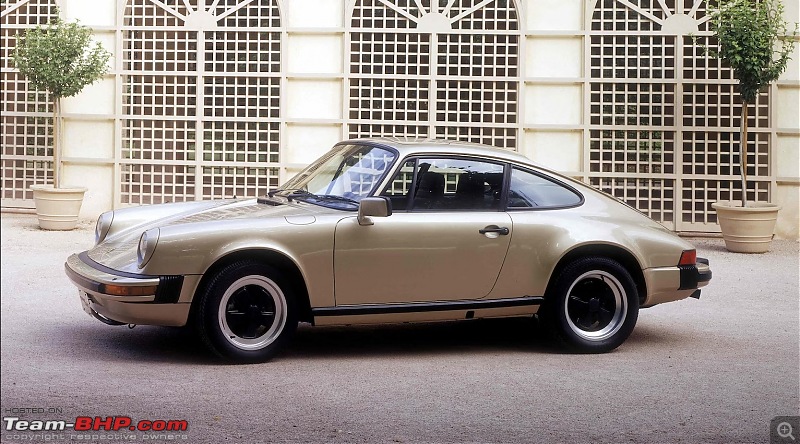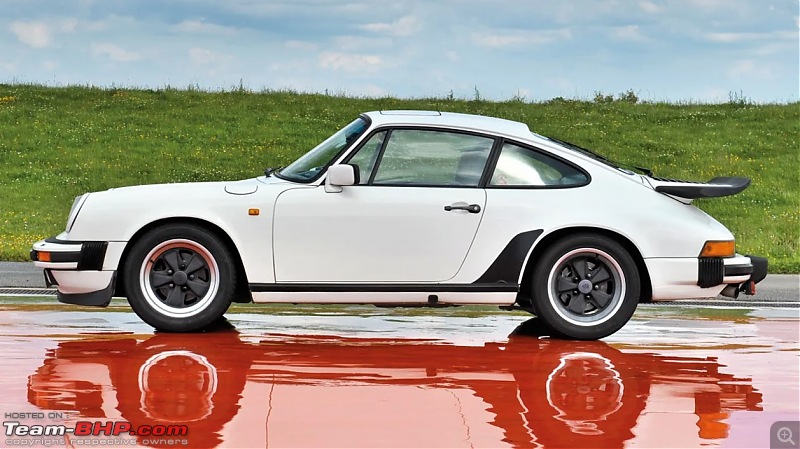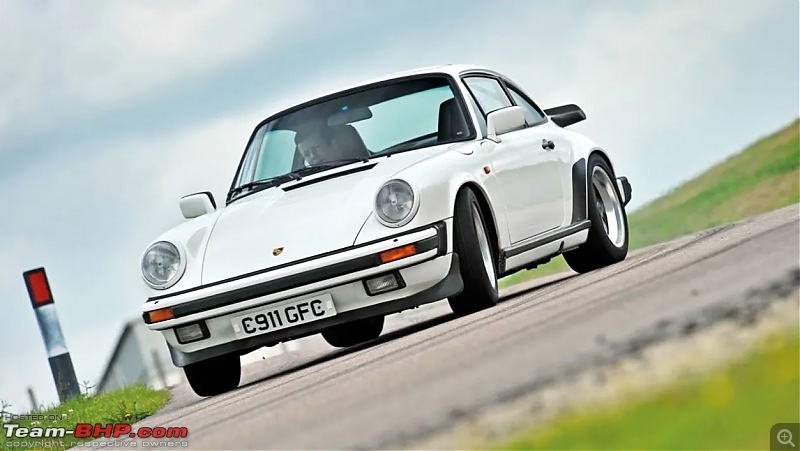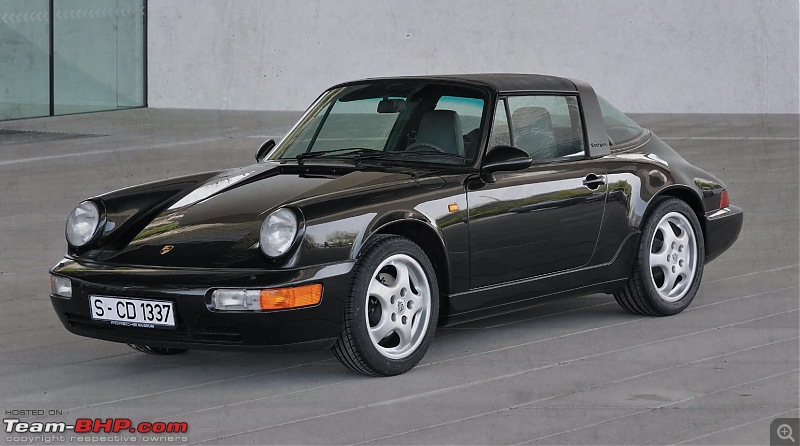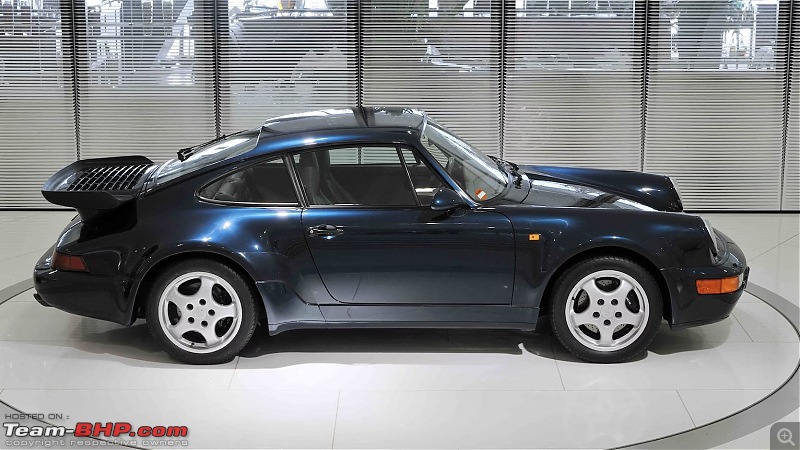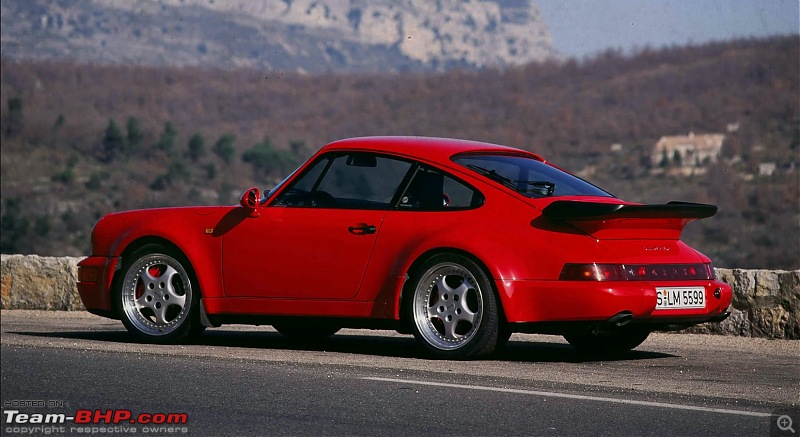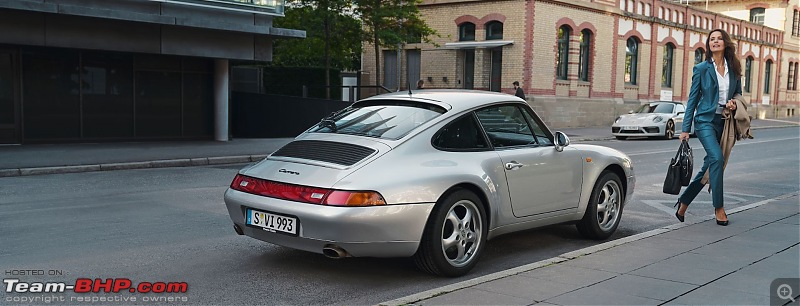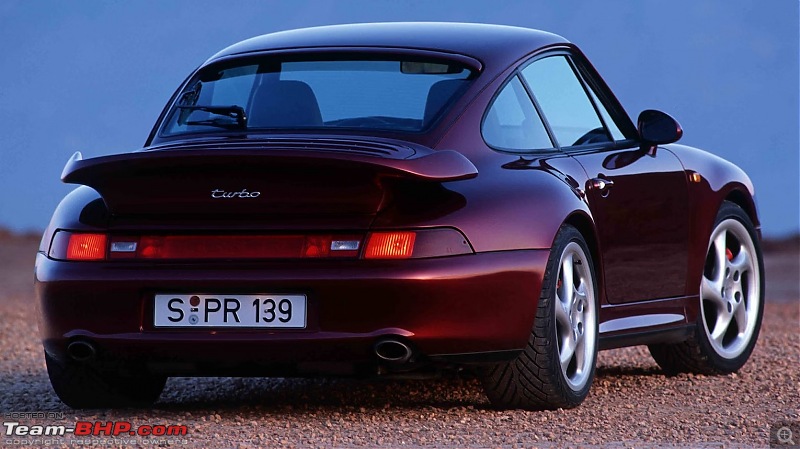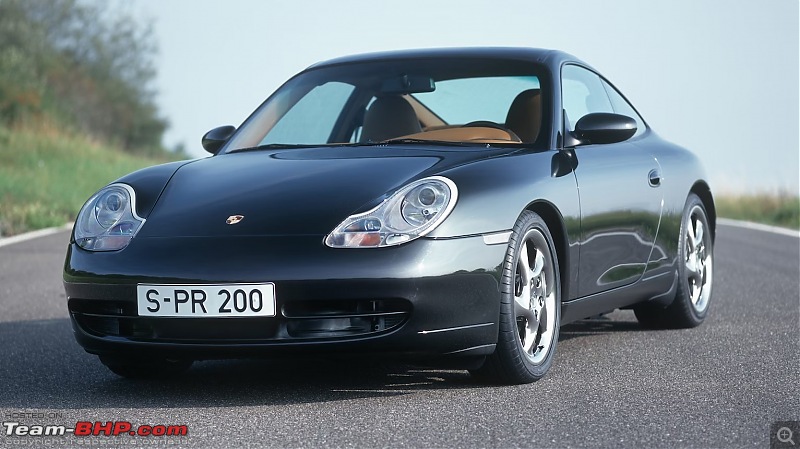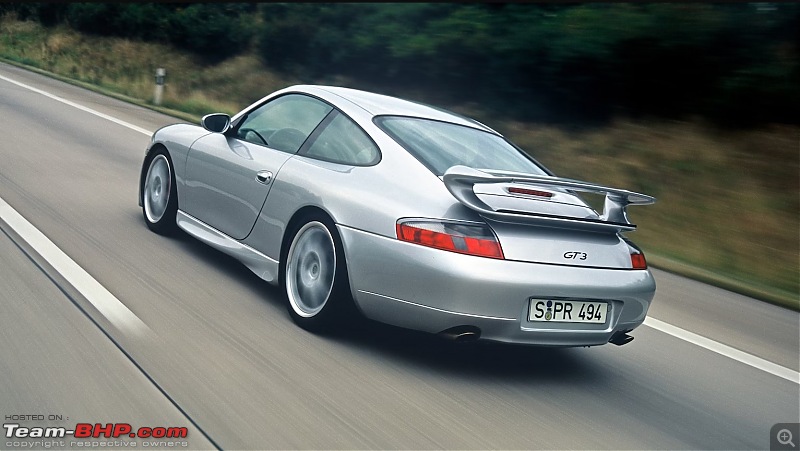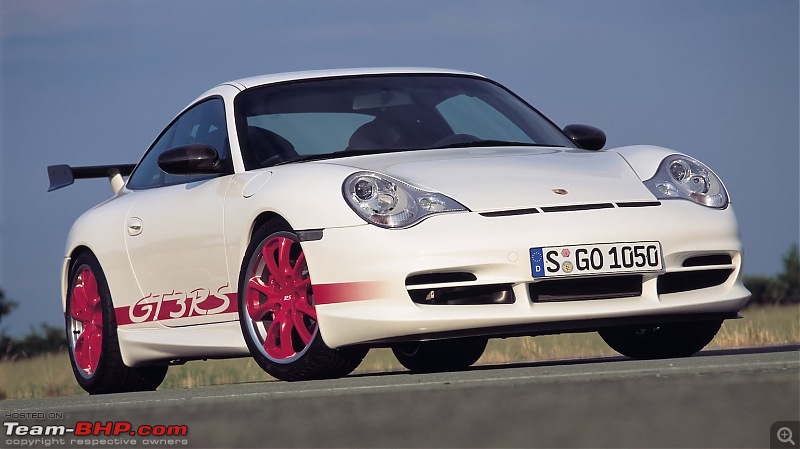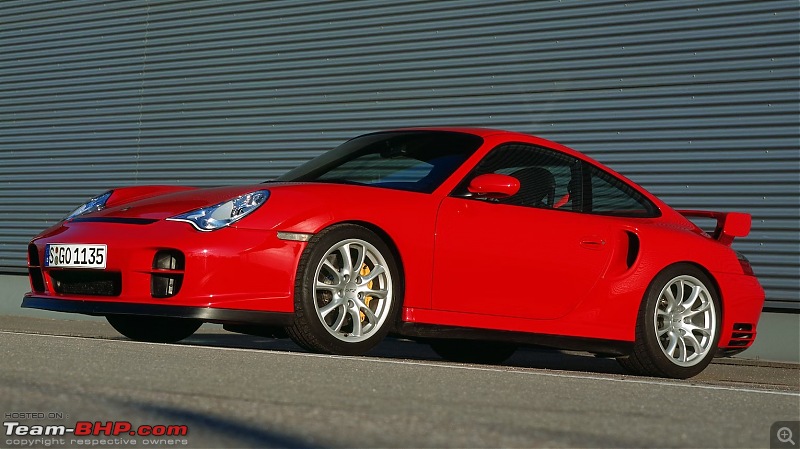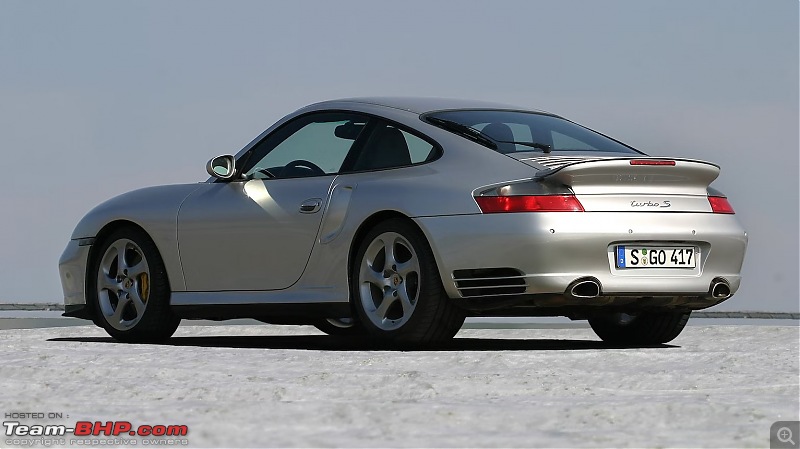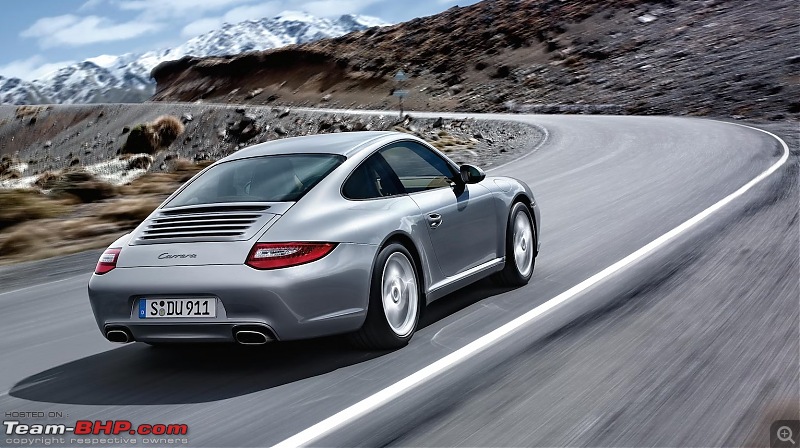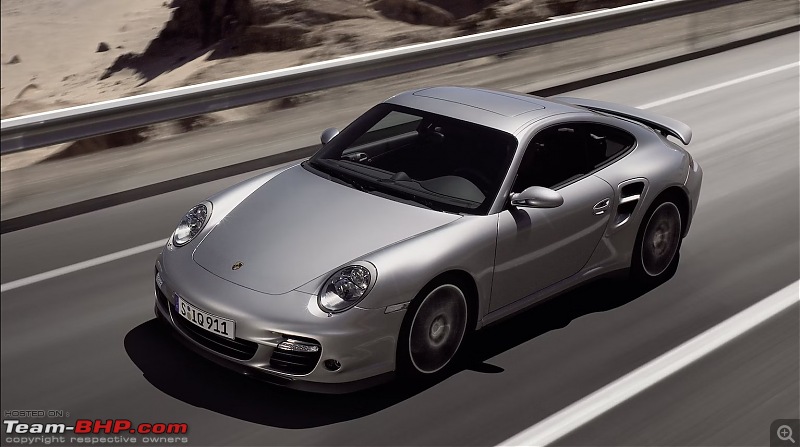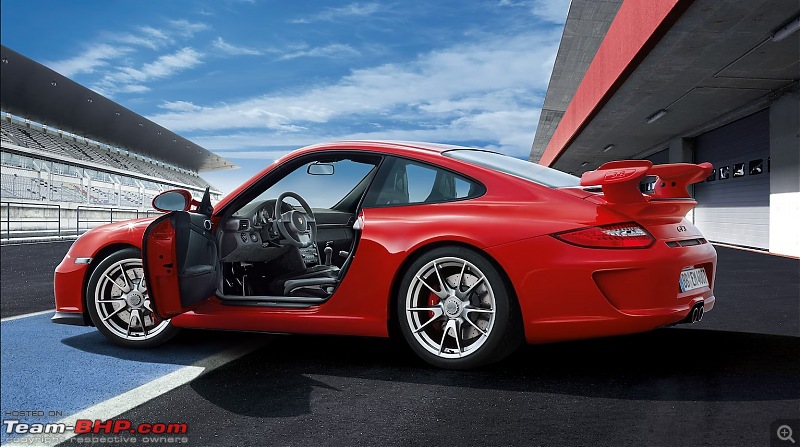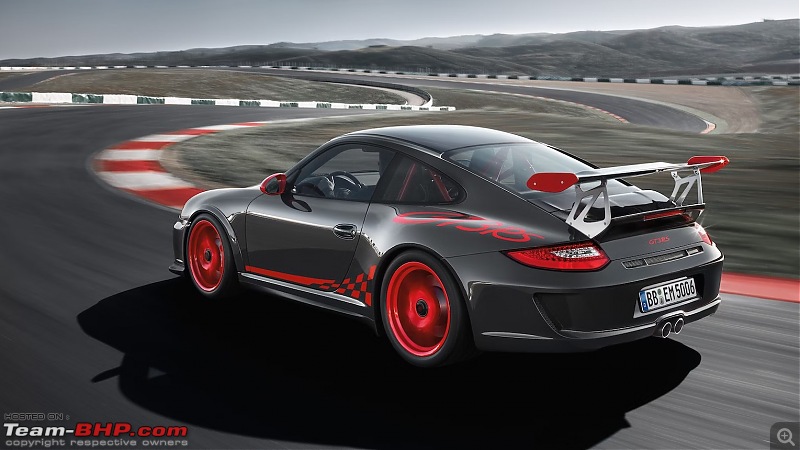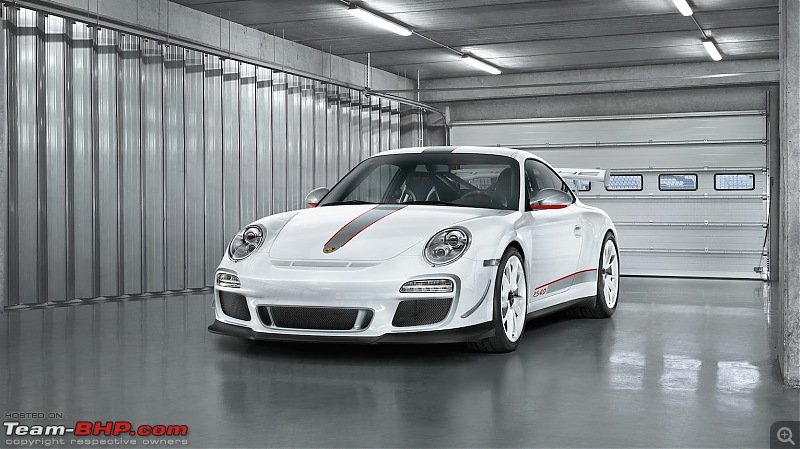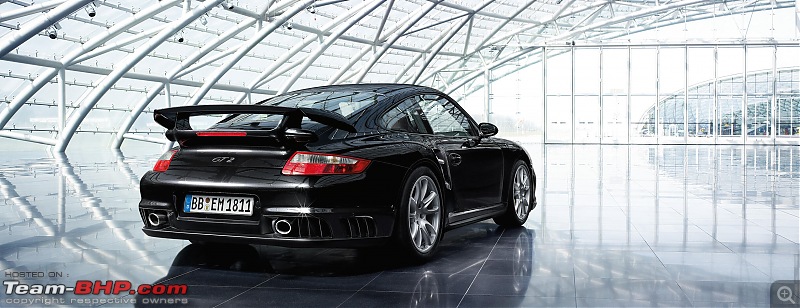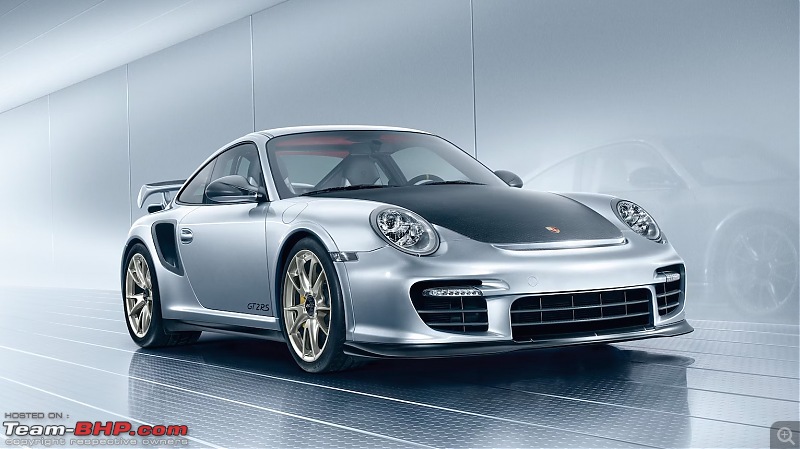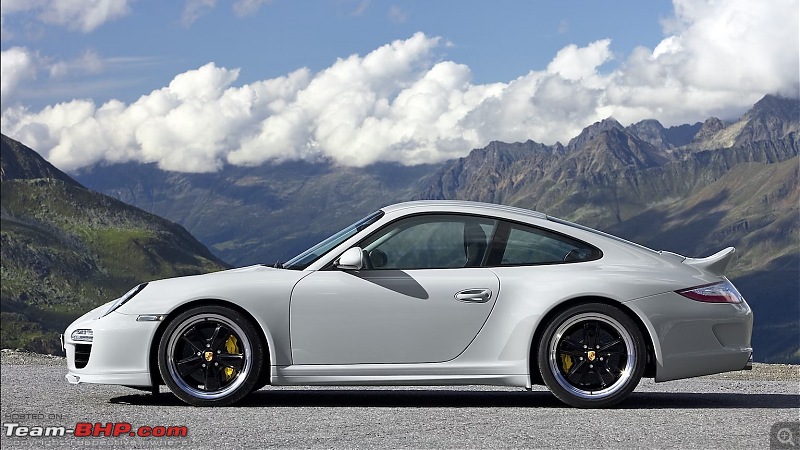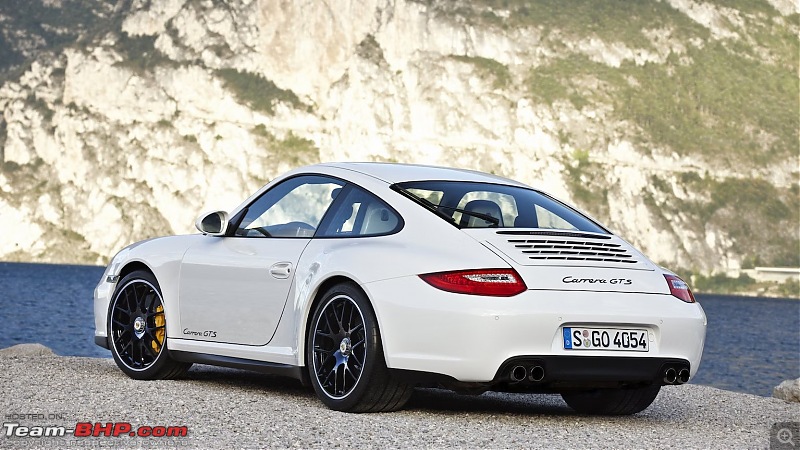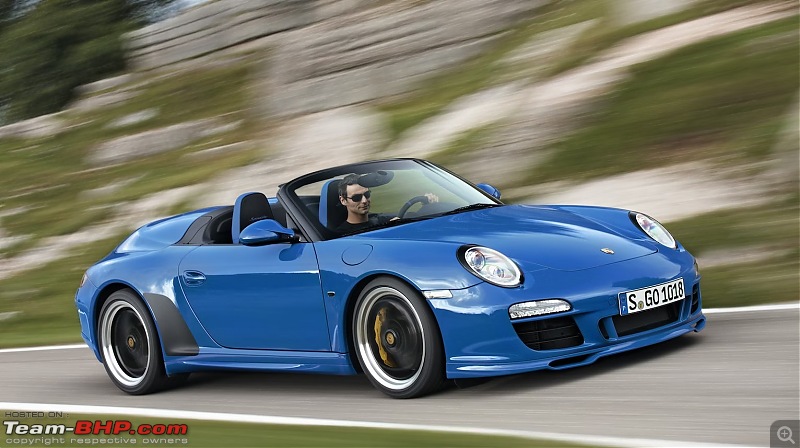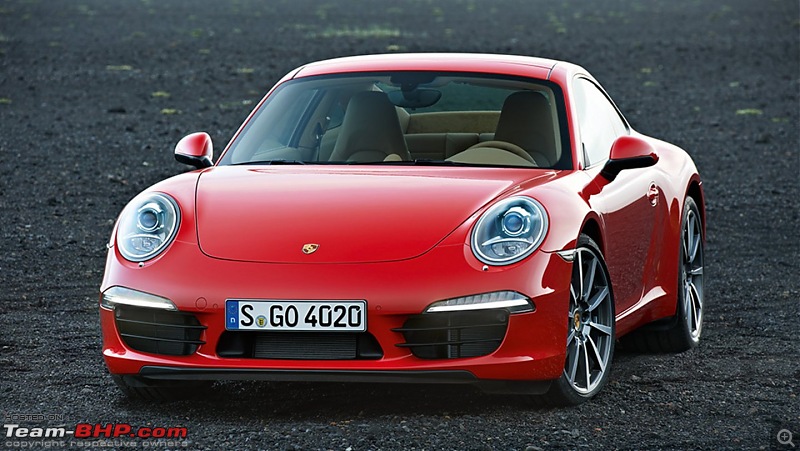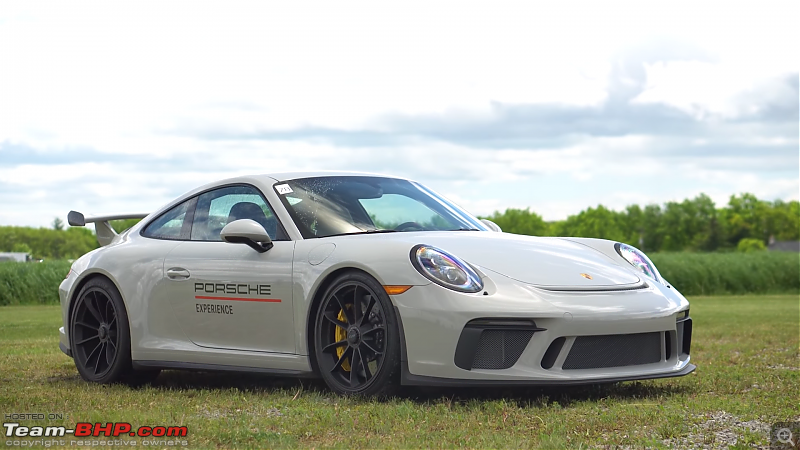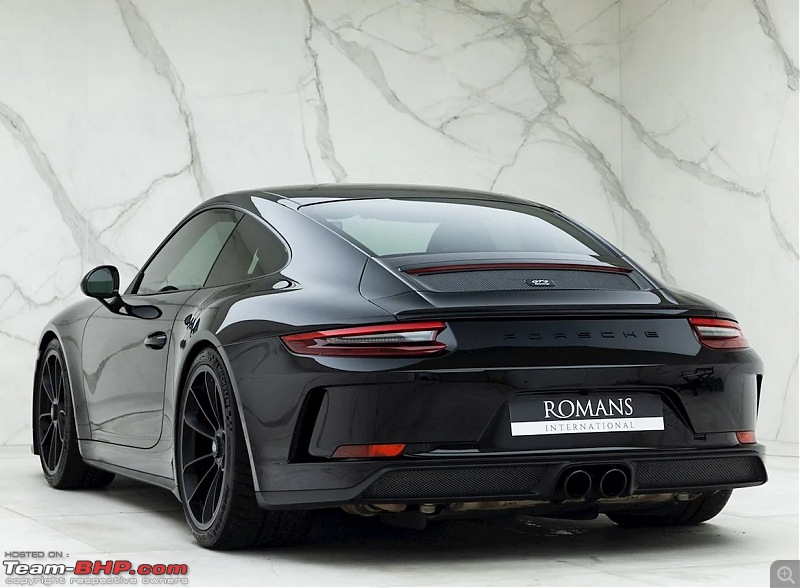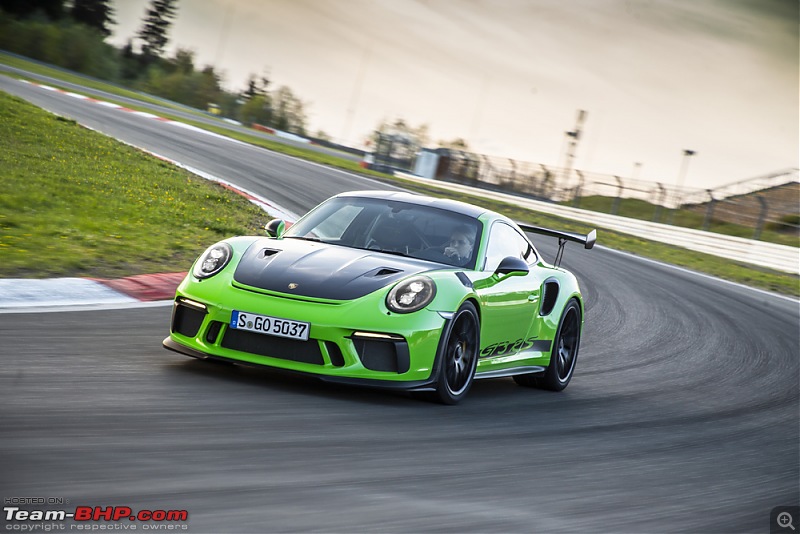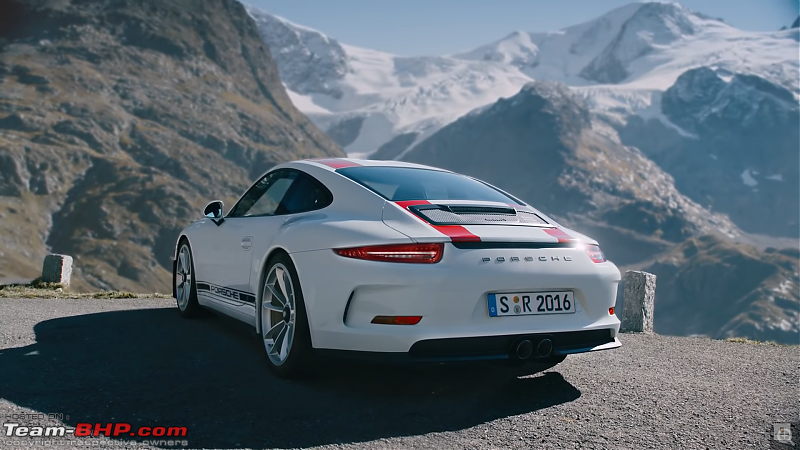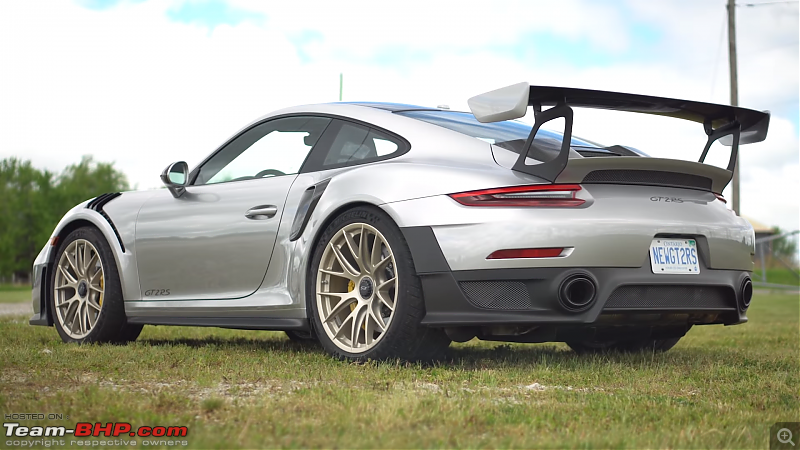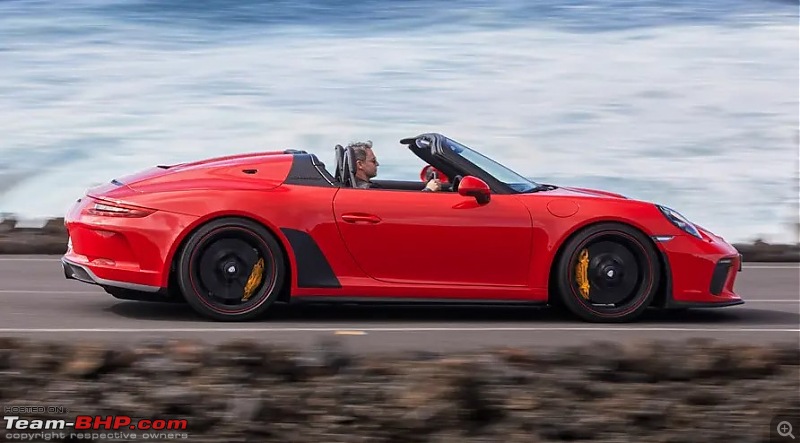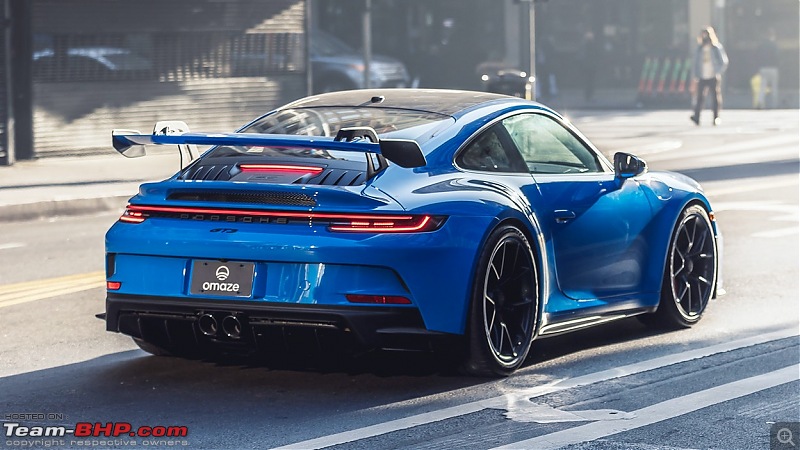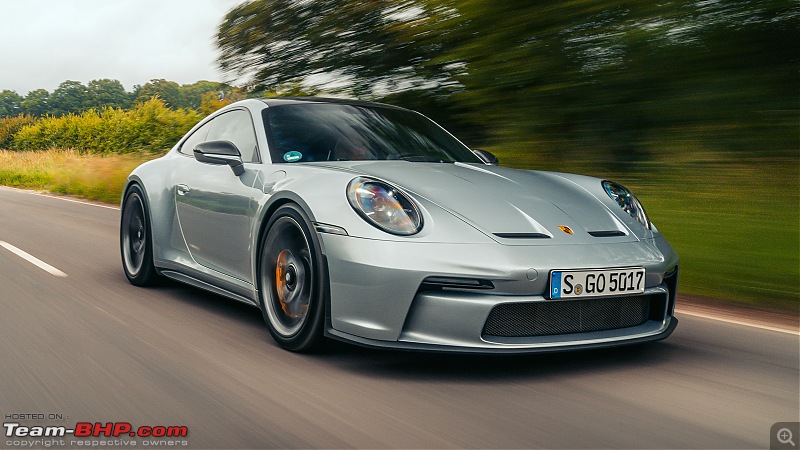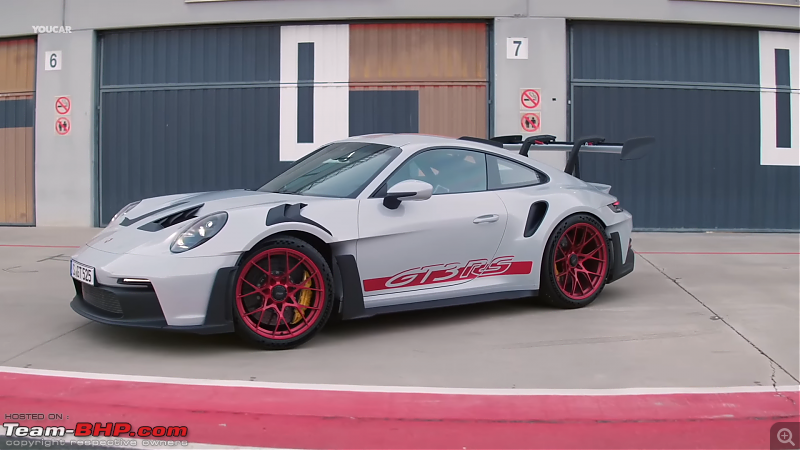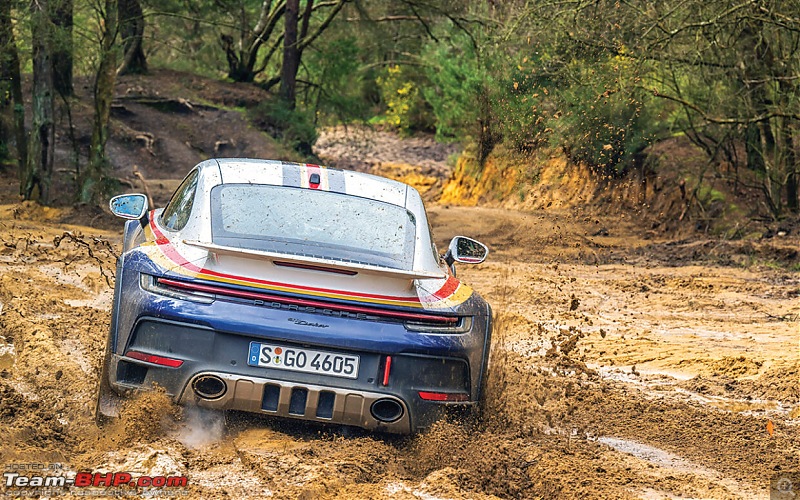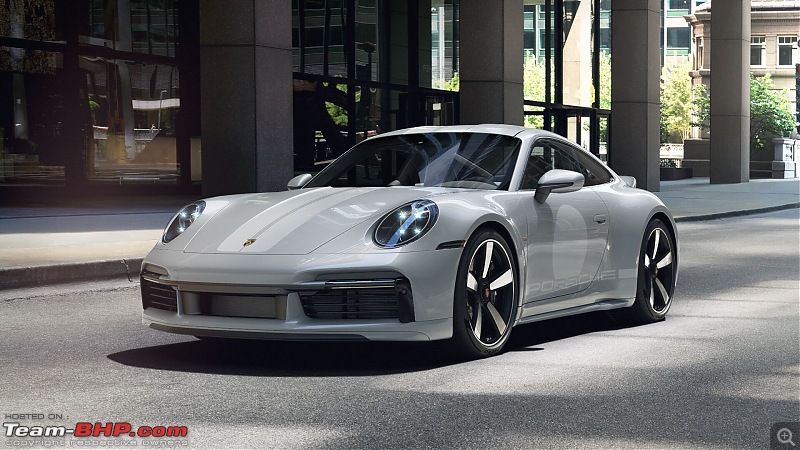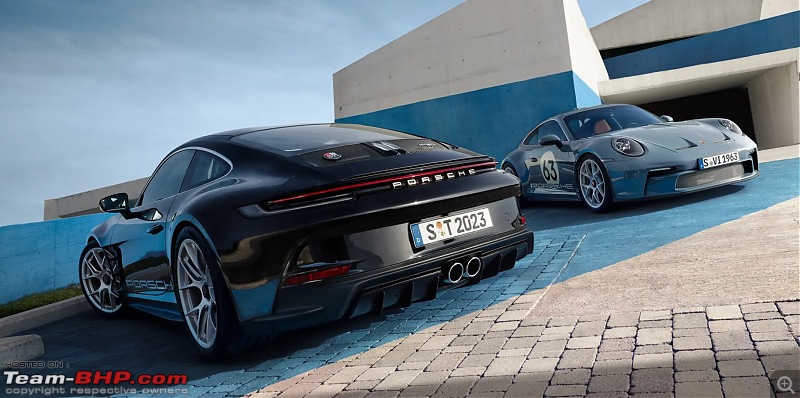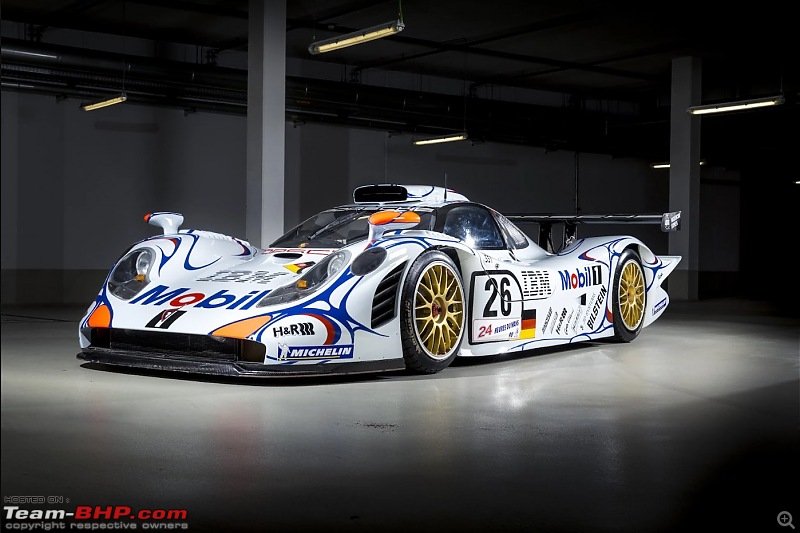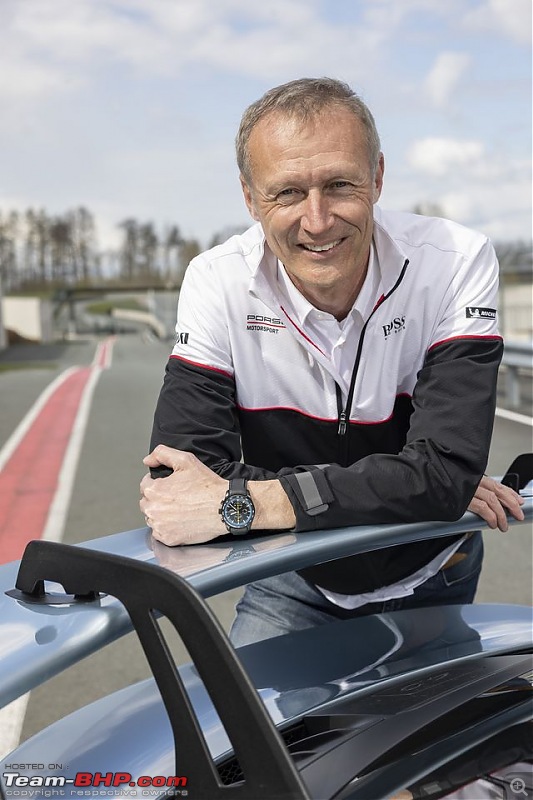| |||||||
| Search Forums |
| Advanced Search |
| Go to Page... |
 |
| Search this Thread |  6,380 views |
| | #1 |
| BHPian Join Date: Oct 2023 Location: Sonipat, HR
Posts: 83
Thanked: 970 Times
| Evolution of the Porsche 911 Hi, BHPians. As much as I am obsessed with JDM cars, I have mad respect for Porsche especially their 911 GT cars. This thread is for the Porsche Purists, enjoy. Dr. Ing. h.c. F. Porsche AG, usually shortened to Porsche is a German automobile manufacturer specializing in high-performance sports cars, SUVs and sedans, headquartered in Stuttgart, Baden-Württemberg, Germany. Origin Ferdinand Porsche (1875–1951) founded the company called "Dr. Ing. h. c. F. Porsche with Adolf Rosenberger and Anton Piëch in 1931. The main offices was at Kronenstraße 24 in the centre of Stuttgart. Initially, the company offered motor vehicle development work and consulting, but did t build any cars under its own name. One of the first assignments the new company received was from the German government to design a car for the people; that is, a Volkswagen. This resulted in the Volkswagen Beetle, one of the most successful car designs of all time. Company logo Porsche's company logo stems from the coat of arms of the Free People's State of Württemberg of Weimar Germany of 1918–1933, which had Stuttgart as its capital.(The Bundesland of Württemberg-Hohenzollern used the same arms from 1945 to 1952, while Stuttgart during these years operated as the capital of adjacent Württemberg-Baden.) The arms of Stuttgart appear in the middle of the logo as an inescutcheon, for the company had its headquarters in Stuttgart. The heraldic symbols, combined with the texts "Porsche" and "Stuttgart", do not form a conventional coat of arms, since heraldic achievements never spell out the name of the armiger nor the armiger's home town in the shield. Porsche 911“The 911 is the only car that you can drive from an African safari to Le Mans, then to the theatre and onto the streets of New York.” - Ferry PorscheThe Porsche 911 (pronounced Nine Eleven or in German: Neunelf) is a two-door 2+2 high performance rear-engined sports car introduced in September 1964 by Porsche AG of Stuttgart, Germany. It has a rear-mounted flat-six engine and originally a torsion bar suspension. The car has been continuously enhanced through the years but the basic concept has remained unchanged. The engines were air-cooled until the introduction of the 996 series in 1998. The 911 has been raced extensively by private and factory teams, in a variety of classes. It is among the most successful competition cars. In the mid-1970s, the naturally aspirated 911 Carrera RSR won world championship races including Targa Florio and the 24 Hours of Daytona. The 911-derived 935 turbo also won the 24 Hours of Le Mans in 1979. Porsche won the World Championship for Makes in 1976, 1977, 1978, and 1979 with 911-derived models. 911 nomenclature Although Porsche has used internal code numbers for each series of the 911, all models have been marketed and sold as 911s. The model series and associated internal codes are as follows:
911s have also been categorized into families based on body styles or engine enhancements: 911 Carrera: including the Carrera, Carrera S, Carrera 4, Carrera 4S, Carrera GTS, Carrera 4 GTS, Carrera T. All are available as cabriolets except the Carrera T. 911 Targa: including the Targa 4, Targa 4S, Targa 4 GTS. 911 Turbo: including the Turbo, Turbo S. All are available as cabriolets. GT3/GT3 RS: a track-focused version of the 911 Carrera with a naturally aspirated engine and rear wheel drive. No cabriolet variant has ever been produced to date. A grand touring version featuring comfort-oriented options is called the GT3 Touring, and is available for the 991 and 992 generations. GT2/GT2 RS: the highest performance derivative, a track-focused version based on the Turbo with rear wheel drive. No cabriolet version has ever been produced to date. Now available as an RS (Renn Sport) model only. Last edited by JDMBOI : 18th November 2023 at 14:15. |
| |  (24)
Thanks (24)
Thanks
 |
| The following 24 BHPians Thank JDMBOI for this useful post: | BK2008, brownkaiser, dan_nx, dean5545, DicKy, GeeTee TSI, GTO, H0RSEPOWER, Harjot37, HumbleBee, IanNazareth, KarthikK, LONG_TOURER, nmenon, pheru8b, pikoh, RaceCyborg, rehaan2, sanjayrozario, Sen, Shreyas Aterkar, The Rationalist, V.Narayan, vinay5795 |
| |
| | #2 |
| BHPian Join Date: Oct 2023 Location: Sonipat, HR
Posts: 83
Thanked: 970 Times
| re: Evolution of the Porsche 911 Air-cooled engines (1964–1998)911, 911S, 911T, 911L, 911E The 911 traces its roots to sketches drawn by Ferdinand "Butzi" Porsche in 1959. The Porsche 911 was developed as a more powerful, larger and a more comfortable replacement for the 356, the company's first model. The new car made its public debut at the 1963 Frankfurt Motor Show (German: Internationale Automobil-Ausstellung). The car was developed with the proof-of-concept twin-fan Type 745 flat-six engine, but the car presented at the auto show had a non-operational mockup of the single-fan 901 engine, receiving a working unit in February 1964. The first models of the 911 had a rear-mounted 130 hp (97 kW) Type 901/01 flat-6 engine, in the "boxer" configuration like the 356, the engine is air-cooled and displaces 1,991 cc (2.0 L) as compared to the 356's four-cylinder, 1,582 cc (1.6 L) unit. The car had four seats although the rear seats were small, thus it is usually called a 2+2 rather than a four-seater (the 356 was also a 2+2). A four or five-speed "Type 901" manual transmission was available. The styling was largely penned by Ferdinand "Butzi" Porsche, son of Ferdinand "Ferry" Porsche. Butzi Porsche initially came up with a notchback design with proper space for seating two rear passengers but Ferry Porsche insisted that the 356's successor was to use its fastback styling. 7 prototypes were built based on Butzi Porsche's original design and were internally called the Porsche 754 T7.Erwin Komenda, the leader of the Porsche car body construction department who initially objected, was also involved later in the design. Porsche 901In September 1963, Porsche introduced the public to the Porsche 901 – the successor to the Porsche 356 – at the IAA in Frankfurt. Series production of the 901 began in September 1964. It originally was designated as the "Porsche 901" (901 being its internal project number). When Porsche exhibited the vehicle at the Paris Motor Show in October of the same year, the French car manufacturer Peugeot became aware of the model designation and objected to it. The reason for this was that Peugeot had patented the type designation consisting of three-digit numbers with a zero in the middle. Porsche renamed the 901 to the 911. This number sequence is the emergency service number in the USA and was therefore already well known in this important market for Porsche. In total, 82 units of the 901 were produced before the name was changed. Porsche 911In September 1963, Porsche introduced the public to the Porsche 901 – the successor to the Porsche 356 – at the IAA in Frankfurt. One year later, from September 1964, series production began on the model, which was soon renamed the 911. The 911, which had until that point only been built as a Coupé, had a self-supporting body and was driven by a new 2.0-litre six-cylinder boxer engine, capable of producing 130 PS. From the model year 1967, the 911 was also available as a "safety cabriolet" (Targa) with a fixed roll bar and a removable folding roof. From September 1968, the wheelbase was extended by 57 mm, which led both to increased driving comfort and more stable driving dynamics. The 911 S – the first engine derivative of the 911 – was also launched. In the years to come, models with the additional designations T, L and E followed. 911 Targa (MY 1967–73) In introducing the Targa model, Porsche was responding to increased safety requirements for open vehicles in the USA. The fixed bar protected the occupants from injury in the event that the car rolled over. 911 S (MY 1967–73) Various modifications to the engine meant that this sports version of the 911 had an initial power output of 160 PS, which eventually increased to 190 PS. In addition to better equipment, the S model was the first 911 to be fitted with the Fuchsfelgen (Fuchs wheels), featuring the characteristic five-spoke design. 911 T (MY 1968–73) The "Touring" became the new entry-level model in the 911 series, initially with 110 PS and later with 130 PS. Its equipment was the same as that in the four-cylinder 912. One way in which it differed from the more powerful models was that its lettering was Silver instead of Gold. 911 L (MY 1968) With the introduction of the T version as a new basic model with a less-powerful engine and four-speed manual transmission, the previous 911 was renamed to 911 L. The engine remained the same. 911 E (MJ 1969-73) The previous 2.0-litre engines entered their last year of construction in MY 1969 and were replaced with new 2.2-litre units. The L version was renamed the 911 E when the engine generation changed and had power outputs of between 140 and 165 PS. 911 Carrera RS (1973 and 1974) RS stands for Rennsport in German, meaning race sport. The Carrera name was reintroduced from the 356 Carrera which had itself been named after Porsche's class victories in the Carrera Panamericana races in Mexico in the 1950s. The RS was developed to meet motorsport homologation requirements. Compared to a standard 911S, the Carrera 2.7 RS had a larger engine (2,687 cc) developing 210 PS (150 kW; 210 hp) with Bosch (Kugelfischer) mechanical fuel injection, revised and stiffened suspension, a "ducktail" rear spoiler, larger brakes, wider rear wheels and rear fenders, to fit 185/70VR15 & 215/60VR15 Pirelli Cinturato CN36 tyres. The 911 RSR For the 1974 IROC Championship (which started in December 1973), 1973 Carrera RSR models were fitted with the 3.0 engine and a flat "whale tail" in place of the ducktail spoiler along with wide body panels and large tyres. 911 and 911S 2.7 (1973–1977) The 1974 model year brought many significant changes to the 911 to meet legislative requirements around the world for both impact safety and emissions. First, the engine size was increased to 2,687 cc achieving higher torque. Second, new impact bumpers conformed with low-speed protection requirements of US regulations. Thirdly, the use of K-Jetronic CIS Bosch fuel injection in two of the three models in the line up— the 911 and 911S models, retaining the narrow rear arches of the old 2.4, now had a 2.7-litre engine rated at 150 PS (110 kW; 150 hp) and 175 PS (129 kW; 173 hp), respectively. The standard 911 version received an increase to 165 PS (121 kW; 163 hp) for Model Year 1976, which meant that starting from MY 1976, there was only a difference in power of 10 hp between the 911 and the 911S. The engine remained a K-Jetronic 2.7-litre. The 911S 2.7 engine was rated during the entire lifespan at 175 hp (130 kW; 177 PS). Video - Carrera 2.7 MFI and CIS (1974–1976) The Carrera 2.7 model built for all markets, except for the United States, used the 210 PS (150 kW; 210 hp) RS 911/83 engine with Bosch mechanical fuel injection pump from the 1973 Carrera RS. These Carrera 2.7 MFI models were built from 1974 until 1976 and were mechanically identical to the 1973 Carrera RS 912E (1976) For the 1976 model year, the 912E was produced for the U.S. market. This was a 4-cylinder version of the 911 in the same manner as the 912 that had last been produced in 1969. It used the I-series chassis powered by the Volkswagen 2.0 engine also used in the Porsche 914 for 1973 through 1975 model years. 2,099 units were produced. The 912E was replaced by the front-engine Porsche 924 for the 1977 model year. Carrera 3.0 (1976–1977) For the 1976 model year, Porsche introduced the Carrera 3.0 with wide rear flares, optional whaletail, and a variety of other luxury options. It was available in all markets except North America. The Carrera 3.0 was fitted with a variation of the 930 Turbo's 2994 cc engine (minus the turbocharger). The engine (dubbed the 930/02) featured K-Jetronic CIS. It developed 200 PS (150 kW; 200 hp) in contrast to the older Carrera 2.7 MFI model's 210 PS (150 kW; 210 hp). The crankcase and gearbox housing were made of aluminium rather than magnesium for improved reliability. Magnesium cases were reviled for thermal expansion/contraction issues as engines grew in displacement and heat generation also increased. The new engine, which featured bigger intake and exhaust valves, produced greater torque allowing the Carrera 3.0 to achieve the same performance as the previous Carrera 2.7, 0–100 km/h (0–62 mph) in 6.1 seconds and 0–200 km/h (0–124 mph) in 27 seconds. Both versions boasted a top speed of approximately 236 km/h (147 mph).Weight increased marginally by 45 kg to 1,120 kg. The 911 Carrera 3.0 was produced in both targa (1,125 examples produced) and coupé (2,566) versions. The Carrera 3.0 was available with a manual gearbox (type 915) with 4 or 5 speeds as well as 3-speed automatic transmission (called the Sportomatic). Production totals were 3,691 manual cars and 58 Sportomatic cars. 930 Turbo and Turbo Carrera 3.0-litre (1975–1977) (930 Turbo is known as "The Widowmaker") For the 1975 model year, Porsche introduced the first production turbocharged 911. Although called the 930 Turbo (930 being its internal type number) in Europe, it was marketed as the 930 Turbo Carrera in North America. The body shape incorporated wide wheel-arches to accommodate the wide 205/50R15 & 225/50R15 Pirelli P7 tyres, and a large rear spoiler often known as a "whale tail" on the early cars (modified from the original 1974 IROC design). They were initially fitted with a 3.0-litre engine 260 PS (190 kW; 260 hp) and four-speed manual transmission. 930 Turbo 3.3-litre (1978–1989) For the 1978 model year, Porsche revised the 930 with a larger 3.3-litre turbocharged engine with intercooler rated at 300 PS (220 kW; 300 hp). To fit the intercooler a newly designed "tea-tray" tail spoiler replaced the earlier whale tail spoiler. Porsche dropped the "Carrera" nomenclature for the North American markets and the car was simply called the Porsche 911 Turbo worldwide. The larger engine helped reduce some of the turbo lag inherent in the earlier models. In 1989, a 5-speed manual transmission became available for the 930. The 930 was replaced in 1990 with the 964 turbo featuring the same 3.3-litre engine. There have been turbocharged variants of each subsequent generation of 911 since then. 911SC (1978–1983) In 1978, Porsche introduced the new version of the 911, called the '911SC'. Porsche reintroduced the SC designation for the first time since the 356SC (as distinguished from the race engined 356 Carrera). There was no Carrera version of the 911SC. According to modern-day Porsche literature and websites (there is no period reference to SC meaning anything) the "SC" stands for "Super Carrera". It featured a 3.0-litre aluminum engine with Bosch K-Jetronic fuel injection and a 5-speed 915 transmission. Originally power output was 180 PS (130 kW; 180 hp), later 191 PS (140 kW; 188 hp) and then in 1981 it was increased to 204 PS (150 kW; 201 hp). Carrera 3.2 (1984–1989) The replacement for the SC series came in 1984 as the 911 3.2 Carrera, reviving the Carrera name for the first time since 1977. This was the last iteration in the original 911 series, with all subsequent models featuring new body styling and new brake, electronic, and suspension technologies. A new higher-displacement engine, a 3.2-litre horizontally opposed flat 6-cylinder unit, was utilized. At the time Porsche claimed it was 80% new. The new swept volume of 3,164 cc was achieved using the 95 mm (3.7 in) bore (from the previous SC model) combined with the 1978 Turbo 3.3 crankshaft's 74.4 mm (2.9 in) stroke. Video - 964 Series (1989–1993) For 1989 the 911 underwent a major evolution with the introduction of the Type 964. It was launched as the Carrera 4, the "4" indicating four-wheel-drive, demonstrating the company's commitment to engineering. Drag coefficient was down to 0.32. A rear spoiler deployed at high speed, preserving the purity of design when the vehicle was at rest. The chassis was redesigned overall. Coil springs, ABS brakes and power steering made their debut. The engine was increased in size to 3,600 cc and was rated at 250 PS (180 kW; 250 hp). The rear-wheel-drive version, the Carrera 2, arrived a year later. 964 Turbo (1990–1994) For the 1991 through 1993 model years, Porsche produced the 964 Turbo with the 930's proven 3.3 L engine, improved to have a power output of 320 PS (240 kW; 320 hp). 1994 brought the Carrera 2/4's 3.6 L engine, now in turbocharged form and sending a staggering 360 PS (265 kW; 355 hp) to the rear wheels. With the 993 on the way, this car was produced through 1994 and remains rather rare. 993 Series (1994–mid 1998) The 911 was again revised for model year 1994 under the internal name Type 993. This car was significant as it was the final incarnation of the air-cooled 911 first introduced in 1964. Most enthusiasts and collectors consider the 993 to be the best of the air-cooled 911 series. As Car & Driver noted, "Porsche's version of the Goldilocks tale is the 993-generation 911, the one many Porschephiles agree that the company got just right," with an "ideal blend of technology and classic 911 air-cooled heritage." Porsche itself refers to the 993 as "a significant advance, not just from a technical, but also a visual perspective." "993s especially [are] widely regarded as the best the 911 ever got. The new suspension, along with chassis refinements, enabled the car to keep up dynamically with the competition. Engine capacity remained at 3.6 L, but power rose to 272 PS (200 kW; 268 hp) due to better engine management and exhaust design, and beginning with model year 1996 to 286 PS (210 kW; 282 hp). 993 Turbo (1995–1997) A Turbocharged version of the 993 was launched in 1995 and became the first standard production Porsche with twin turbochargers and the first 911 Turbo to be equipped with permanent all-wheel-drive (the homologated GT2 version based on the Turbo retained RWD). The 3.6 L twin-turbocharged M64/60 engine is rated at 408 PS (300 kW; 402 hp)). The performance was outstanding at the time, as 0 to 97 km/h (60 mph) has been measured at 3.2 seconds, and the braking was even more impressive in 2.3 seconds from the same speed. The car's top speed was measured at 322 km/h (200 mph) at 7,000 rpm. Last edited by JDMBOI : 18th November 2023 at 09:18. |
| |  (22)
Thanks (22)
Thanks
 |
| The following 22 BHPians Thank JDMBOI for this useful post: | 14000rpm, brownkaiser, dean5545, GeeTee TSI, GTO, Harjot37, HumbleBee, IanNazareth, KarthikK, keroo1099, nettooran, nmenon, pikoh, RaceCyborg, rehaan2, sainyamk95, Samfromindia, sanjayrozario, Shreyas Aterkar, SmartCat, The Rationalist, V.Narayan |
| | #3 |
| BHPian Join Date: Oct 2023 Location: Sonipat, HR
Posts: 83
Thanked: 970 Times
| re: Evolution of the Porsche 911 Water-cooled engines (1998–present)996 (1999–2005) The Type 996 introduced in 1998 represented two major changes for the venerable 911 lineage: a water-cooled flat-6 engine replaced the popular air-cooled engine used in the 911 for 34 years and the body shell received its first major re-design. Changing to a water-cooled engine was controversial with Porsche traditionalists, who noted this as the end of the 'true' 911. Engine displacement was 3.4 L and power output was 300 PS (221 kW; 296 hp) featuring a change to an "integrated dry sump" design and variable valve timing. The displacement was increased in 2002 to 3.6 L and power received an increase to 320 PS (235 kW; 316 hp). 996 GT3 (1999–2004) (There are 2 GT3 996.1 & 996.2) Porsche introduced a road-legal GT3 version of the 996 series which was derived from the company's racing car used in the GT3 class racing. Simply called GT3, the car featured lightweight materials including thinner windows and deletion of the rear seats. The GT3 was a lighter and more focused design with an emphasis on handling and performance, a concept that dates back to the 1973 Carrera RS. The suspension ride height was lowered and tuned for responsiveness over compliance and comfort. These revisions improved handling and steering. Of more significance was the engine used in the GT3. Instead of using a version of the water-cooled units found in other 996 models, the naturally aspirated engine was derived from the 911 GT1 '98 sports-prototype racing car and featured lightweight materials which enabled the engine to have higher rpm. The engine used was a naturally aspirated 3,600 cc (3.6 L) flat-six rather than the engine from the pre-facelift and revised Carrera. It is rated at 365 PS (268 kW; 360 hp) at first and later improved to 386 PS (284 kW; 381 hp) at the end of the 996 series' revision. 996 GT3RS (There are 2 GT3RS 996.1 & 996.2) In 2003, Porsche introduced the Porsche 911 GT3 RS, an even more track-focused version of the 996 GT3. RS is short for the German RennSport, literally "racing sport" in English. The "RS" moniker, and the characteristic lightweight blue or red wheels and "GT3 RS" side stickers link the 996 GT3 RS to historically important Porsches such as the Carrera 2.7 RS of the early 1970s. The 996 GT3 RS is lighter than the 996 GT3 thanks to a polycarbonate rear window, carbon fibre hood and rear wing. Porsche Ceramic Composite Brake (PCCB) Carbon fibre-reinforced Silicon Carbide ceramic composite brakes, which are also more heat and fade resistant than the cast iron units fitted as standard, were optional. Specifications Body in Carrera White // Option to choose red or blue “911 GT3 RS” decal logo on the vehicle flanks and at the rear // Red or blue wheel centres // Rear lid with tear-off edge and dust collector // Fixed rear wing made of visible carbon // Exterior mirror with carbon look // Shell seats with flame-retardant upholstery // Three-point seat belts in Red or Blue // Six-point belt for the driver’s side (included) // Roll cage // Fire extinguisher (included) // 381-HP naturally aspirated engine, six-speed manual transmission and the same brakes as the standard 911 GT3 // Acceleration: from 0 to 100 km/h in 4.4 seconds, from 0 to 200 km/h in 14 seconds // Maximum speed: 306 km/h 996 GT2 From model year 2001, the model range was extended to include the 911 GT2. The body of the extreme sports car was based on the body of the 911 Turbo. The GT2 engine was also based on the 911 Turbo but had ten percent more power. The bi-turbo engine delivered 462 horsepower. The GT2 was offered with a Clubsport Package for use in motorsport. The successor to the GT2 was offered from model year 2003 onwards. The body of the new GT2 was not modified but the 3.6-litre engine had even more power. The bi-turbo engine delivered a staggering 483 horsepower. The new GT2 was also available with a Clubsport Package. 996 Turbo (2001–2005) In 2000, Porsche launched the turbocharged version of the Type 996 for the 2001 model year. Like the GT3, the Turbo's engine was derived from the engine used in the 911 GT1 and, like its predecessor, featured twin-turbos and now had a power output of 420 PS (309 kW; 414 hp). Also like its predecessor, the new Turbo was only available with all-wheel drive. In 2002, the X50 package was available that increased the engine output to 450 PS (331 kW; 444 hp) with 620 N⋅m (457 lb⋅ft) of torque across a wide section of the power band. With the X50 package, the car could accelerate from 0–100 km/h (0–62 mph) in 3.91 seconds. Later on toward the end of the 996 life cycle, the Turbo S nameplate also returned with the debut of the cabriolet variant as well. The Turbo S boasted even more power— 450 PS (331 kW; 444 hp) and 620 N⋅m (460 lb⋅ft)— than the standard Turbo courtesy of the X50 package being standard. The Turbo S was limited to 1,500 units worldwide. The Turbo can attain a top speed of 304 km/h (189 mph) Video - 997 (2004–2013) The 996 was replaced with the 997 in 2004, for the 2005 model year. nitially, two versions of the 997 were introduced— the rear-wheel-drive Carrera and Carrera S. While the base 997 Carrera had a power output of 325 PS (239 kW; 321 hp) from its 3.6 L Flat 6, a more powerful 3.8 L 355 PS (261 kW; 350 hp) Flat 6 powers the Carrera S. Besides a more powerful engine, the Carrera S also comes standard with 19 in (48 cm) "Lobster Fork" style wheels, more powerful and larger brakes (with red calipers), lowered suspension with PASM (Porsche Active Suspension Management: dynamically adjustable dampers), Xenon headlamps, and a sports steering wheel. The 997 received a larger air intake in the front bumper, new headlights, new rear taillights, new clean-sheet design direct fuel injection engines, and the introduction of a dual-clutch gearbox called PDK for the 2009 model year. They were also equipped with Bluetooth support. 997 Turbo (There are 2 997 Turbo 997.1 & 997.2) The Turbocharged version of the 997 series featured the same 3.6 L twin-turbocharged engine as the 996 Turbo, with modifications to have a power output of 480 PS (353 kW; 473 hp) and 620 N⋅m (457 lb⋅ft) of torque. It has VTG (variable turbine geometry), that combines the low-rev boost and quick responses of a small turbocharger with the high-rev power of a larger turbocharger. It also offers higher fuel efficiency compared to the 996 Turbo. The 997 Turbo features a new all-wheel-drive system, similar to the one found on the Cayenne. The new PTM (Porsche Traction Management) system incorporates a clutch-based system that varies the amount of torque to the wheels to avoid tyre slippage. According to Porsche, redirecting torque to control oversteer or understeer results in neutral handling as well as greatly improved performance in all weather conditions. For the face lifted 2010 model year 911 Turbo, known internally as the 997.2 (as opposed to the 997.1 2007-2009 model years), launched in August 2009, the PTM system was tweaked to give a more rearward power bias. The paddle shifters for the PDK double-clutch gearbox debuted on the Turbo.The turbo uses a different engine. The previous water-cooled turbo models (996 and 997) measured 3,600cc. This new engine measures 3,800 cc (4 L) and was first developed for the Carrera that was launched in 2008. The variable-vane twin turbochargers have also been reworked to increase responsiveness, and the intercooler and fuel system were uprated. The engine has a power output of 493 PS (363 kW; 486 hp) which is 20 hp more than the outgoing model. The steering wheel also houses a display showing when Sport, Sport Plus and launch control have been selected through the optional Sport Chrono package. Porsche claimed that the new 911 turbo will accelerate from 0 to 100 km/h (0 to 62 mph) in 3.4 seconds, or 0–60 mph in 3.2 seconds and could attain a top-speed of 312 km/h (194 mph). 997 GT3 (There are 2 GT3 997.1 & 997.2) The 911 GT3 was added to the 997 lineage on 23 February 2006. Performance figures include a 0–100 kilometres per hour (0–62 mph) acceleration time of 4.1 seconds and a top speed of 310 km/h (193 mph), almost as fast as the Turbo. Porsche's factory reports were proven to be conservative about the performance of the car; Excellence magazine tested the 997 GT3 and recorded a 0–100 km/h (62 mph) of 3.9 seconds and a top speed of 312 km/h (194 mph). It was at that time crowned "the best handling car in America" by Motor Trend. 997 GT3 RS (There are 2 GT3RS 997.1 & 997.2) The 911 GT3 RS was announced in early 2006 as a homologation version of the GT3 RSR racing car for competition events like Sebring and the 24 Hours of Le Mans. The drivetrain of the RS is based on the 911 GT3, except for the addition of a lightweight flywheel and closer gear ratios for further improved response under acceleration. Unlike the GT3, the RS is built on the body and chassis of the 911 Carrera 4 and Turbo, and accordingly has a wider rear track for better cornering characteristics on the track. Visually, the RS is distinguished by its distinctive colour scheme – bright orange or green with black accents, which traces its roots to the iconic Carrera RS of 1973. The plastic rear deck lid is topped by a wide carbon-fibre rear wing. The front airdam has been fitted with an aero splitter to improve front downforce and provide more cooling air through the radiator. The European version of the RS is fitted with lightweight plexiglass rear windows and a factory-installed roll cage. 997 4.0L GT3RS In April 2011, Porsche announced the third generation of the 997 GT3 RS with an enlarged 4.0-litre engine having a power output of 500 PS (368 kW; 493 hp), Porsche designed the GT3 RS 4.0 using lightweight components such as bucket seats, carbon-fibre bonnet and front wings, and poly carbonate plastic rear windows for weight reduction, while using suspension components from the racing version. Other characteristics include low centre of gravity, a large rear wing and an aerodynamically optimised body. The lateral front air deflection vanes, a first on a production Porsche, increase downforce on the front axle. Aided by a steeply inclined rear wing, aerodynamic forces exert an additional 190 kg, enhancing the 911 GT3 RS 4.0's grip to the tarmac. The GT3 RS 4.0 weighs 1,360 kg (2,998 lb). 997 GT2 The 997 GT2 has a twin-turbocharged 3.6-litre flat-6 engine, which generates 530 PS (390 kW; 523 hp) at 6,500 rpm, and 505 lb⋅ft (685 N⋅m) of torque from 2,200 to 4,500 rpm. It has a 6-speed manual transmission and is rear wheel drive. With a curb weight of 1,440 kg (3,175 lb), the 997 GT2 accelerates from 0–97 km/h (0–60 mph) in 3.6 seconds, and from 0 to 161 km/h (100 mph) in 7.4 seconds, and has a top speed of 328 km/h (204 mph). This makes it the first street-legal 911 to exceed 322 km/h (200 mph) barrier, with the exception of the 1998 911 GT1 road car (which is broadly considered not to be a true 911 due to its mid-mounted engine). Its appearance differs slightly from its sister-car, the 911 (997) Turbo, in a few ways. It does not have fog lights in the front bumper, it has a revised front lip, it has a different rear wing (with two small air scoops on either side), and it has a different rear bumper (now featuring titanium exhaust pipes). 997 GT2 RS On 4 May 2010, an RS variant was announced to German dealers in Leipzig. The GT2 RS develops 620 PS (456 kW; 612 hp) and 700 N⋅m (516 lb⋅ft) of torque and weighs 70 kg (150 lb) less than the standard GT2, allowing for a top speed of 330 km/h (205 mph) and the 0–100 km/h (0–62 mph) acceleration time of 3.4 seconds. Sport Classic Unveiled at the 2009 Frankfurt Auto Show, the Sport Classic is a limited (250 units- all sold in under 48 hours) version of 911 Carrera S coupé, inspired by the 1973 Carrera RS 2.7. The engine is rated at 408 PS (300 kW; 402 hp) via newly developed resonance intake manifold with 6 vacuum-controlled switching flaps. It includes 6-speed manual transmission, double-dome roof, 44 mm (1.7 in) wider rear fenders, SportDesign front apron with a spoiler lip and a fixed 'duck tail' rear wing (similar to the one found on the 1973 Carrera RS 2.7), PCCB Porsche Ceramic Composite Brakes, 20 mm (0.8 in) lower PASM sports suspension, mechanical rear axle differential, 19-inch black Fuchs wheels, Porsche Exclusive woven leather seats and door panels, dashboard with Espresso Nature natural leather upholstery, and a specially developed Sport Classic Grey body colour. Carrera GTS For the 2011 model year, Porsche introduced the first-ever GTS model for the 911. Designed as a driver's car, the GTS was more powerful than the S, better handling via a bespoke suspension design, and positioned as a more street-friendly alternative to the GT3, Porsche's track-focused 911 variant. The GTS featured race-inspired center lock wheels, unique styling including a Sport Design front bumper, special rear bumper, blackout trim, side skirts borrowed from the GT2 model, brushed stainless steel "Carrera GTS" door sills and Alcantara trim. Many GTS' were ordered with the Alcantara delete, instead being built with leather. The GTS was very rare in that it was a rear wheel drive Wide-Body design (44 mm wider than a standard 911), 20 mm lower and offered 408 HP (versus 385 HP for the S) like the similar, limited volume Sport Classic and the Speedster. Porsche built approximately 2,265 total GTS models for the world market, as well as a handful designated as 2012 models. The enthusiastic reception the GTS model received from both the motoring press and consumers, convinced Porsche to make the GTS a staple of the 911 line beginning in 2015, with the "type 991" 911 successor. Speedster In 2011, Porsche added a new 911 Speedster in a limited series of only 356 units to the 997 lineage, the number of cars produced recalling the iconic car of the 1950s. It was the third 911 Speedster produced, the other two being from the 930 and 964 generations. The Speedster was powered by the same engine of the Carrera GTS which is rated at 414 PS (304 kW; 408 hp). It accelerated from 0 to 97 km/h (60 mph) in 4.2 seconds and attained a top speed of around 310 km/h (190 mph). Only two colours were offered, Pure Blue (which was developed specifically for the Speedster) and Carrara White. 991 Series (2011 – 2019) The 991 introduced in 2011 for the 2012 model year is an entirely new platform, only the third since the original 911. At the front, the new 991 has wide-set headlights that are more three-dimensional. The front fender peaks are a bit more prominent, and wedgy directionals now appear to float above the intakes for the twin coolant radiators. The stretched rear 3/4 view has changed the most, with a slightly more voluminous form and thin taillights capped with the protruding lip of the bodywork. The biggest and main change in the interior is the center console, inspired by the Carrera GT and adopted by the Panamera. The 991 is the first 911 to use a predominantly aluminium construction. This means that even though the car is larger than the outgoing model, it is still up to 50 kilograms (110 lb) lighter. The reduced weight and increased power means that both the Carrera and Carrera S are appreciably faster than the outgoing models. The 0–97 km/h (0–60 mph) acceleration time for the manual transmission cars are 4.6 seconds for the Carrera and 4.3 seconds for the Carrera S. When equipped with the PDK transmission, the two 991 models can accelerate from 0–97 km/h (0–60 mph) in 4.4 seconds and 4.1 seconds. With the optional sports chrono package, available for the cars with the PDK transmission, the 991 Carrera can accelerate from 0–97 km/h (0–60 mph) in as little as 4.2 seconds and the Carrera S can do the same in 3.9 seconds 991 GT3 (There are 2 GT3 991.1 & 991.2) Porsche introduced the 991 GT3 at the Geneva Motor Show in 2013.The 991 GT3 features a new 3.8 litre direct fuel injection (DFI) flat-six engine developing 475 PS (349 kW; 469 hp) at 8,250 rpm, a Porsche Doppelkupplung (PDK) double-clutch gearbox and rear-wheel steering. The engine is based on the unit fitted in the 991 Carrera S, but shares only a few common parts. All other components, particularly the crankshaft and valve train, were specially adapted or developed for the 991 GT3. The dual-clutch gearbox is another feature specially developed for the 991 GT3, based on sequential manual transmissions used in racing cars. The 911 GT3 is claimed to be able to accelerate from 0–97 km/h (60 mph) in 3.2 seconds or less, and the quarter mile in 11.2 seconds at 203 km/h (126 mph).The GT3 has a claimed top speed of 315 km/h (196 mph). Porsche unveiled the facelifted 991.2 GT3 at the 2017 Geneva Motor Show. Extensive changes were made to the engine allowing a 9,000 rpm redline from the 4.0 litre flat-six engine. Porsche's focus was on reducing internal friction to improve throttle response. Compared to the 991.1, the rear spoiler is higher and located further back to be more effective. There is a new front spoiler and changes to the rear suspension. The 991.2 GT3 brought back the choice between a manual transmission or PDK dual-clutch transmission. A touring version was also introduced which comes standard with the comfort package and the manual transmission along with the deletion of the fixed rear wing and employing an electronically operated rear wing instead. 991 GT3 Touring Following the roots of the 2016 991.1 911 R, a touring version of the GT3 was introduced that removes the rear wing and replaces it with the modified retractable rear spoiler from the Carrera GTS (with a Gurney flap and 20-degree deployment angle) to give a more smooth and flowing aesthetic image, though it extends further upwards to provide extra downforce. The spoiler deploys at 121 km/h (75 mph) and retracts at 80 km/h (50 mph). It can also be manually deployed by the press of a button. The downforce is 104 kg (230 lb) less than the standard GT3 at top speed. Top speed is also reduced at 315 km/h (196 mph). The Touring is only available with a manual transmission, features leather versus Alcantara, and cannot be specified with the Clubsport package available with the normal GT3. Other options and features remain the same as the GT3. The suspension settings are said to be identical to the standard GT3 as is the engine. However, the air intake replaces the normal GT3's box paper air filters with a conic high flow BMC air filters and adds membrane on the two air filter chambers under the gurney flap that are the reasons of the sound differences between the normal GT3 and the GT3 Touring. 991 GT3 RS (There are 2 GT3RS 991.1 & 991.2) Porsche launched the Renn Sport version of the 911 GT3 at the Geneva Motor Show in 2015. Compared to the 911 GT3, the front fenders are now equipped with louvers above the wheels and the rear fenders now include Turbo-like intakes, rather than an intake below the rear wing. The roof is made from magnesium. The interior includes full bucket seats (based on the carbon seats of the 918 Spyder), carbon-fibre inserts, lightweight door handles and the Club Sport Package as standard (a bolted-on roll cage behind the front seats, preparation for a battery master switch, and a six-point safety harness for the driver and fire extinguisher with mounting bracket). The 3.8-litre unit found in the previous 997 GT3 is replaced with a 4.0-litre unit that has a power output of 500 PS (368 kW; 493 hp) and 460 N⋅m (339 lb⋅ft) of torque. The transmission is PDK only. The car accelerates from 0–100 km/h (62 mph) in 3.4 seconds (0.6 seconds quicker than the 997 GT3 RS 4.0) and 0–200 km/h (124 mph) in 10.9 seconds. The 991 GT3 RS also comes with functions such as declutching by "paddle neutral" — comparable to pressing the clutch with a conventional manual gearbox – and a Pit Speed limiter button. As with the 911 GT3, a rear-axle steering and Porsche Torque Vectoring Plus with fully variable rear axle differential lock are available as standard. In February 2018, Porsche introduced a facelifted GT3 RS model to continue their updates for the 991 generation of the 911. Changes include a new engine similar to the GT3 and RSR models with a 9,000 rpm redline and a 20 PS (15 kW; 20 hp) and 10 N⋅m (7.4 lb⋅ft) increase over the outgoing model, NACA ducts for brake cooling, modified front fascia (similar to the 991.2 GT3), side skits and rear wing (similar to the GT2 RS) for increased downforce, ball joints on all suspension links, front helper springs, lightweight glass for the rear and rear-side windows and a newly developed tyre compound. A Weissach package was available that included additional carbon fibre body and interior parts as well as magnesium wheels and stiffer suspension settings is available as an option. 911 R In 2016, Porsche unveiled a limited production 911 R based on the GT3 RS. Production was limited to 991 units worldwide. It has an overall weight of 1,370 kg (3,020 lb), a high-revving 4.0 L six-cylinder naturally aspirated engine from the 991 GT3 RS, and a six-speed manual transmission, while air conditioning and audio systems are removable options to save weight. The car accelerates from 0–97 km/h (0–60 mph) in 3.7 seconds and has a top speed of 320 km/h (200 mph) 991 GT2 RS The high-performance GT2 version made a return to the 991 lineage but now as an RS variant only with no standard variant being produced, unlike the previous generations. The car was officially launched by Porsche at the 2017 Goodwood Festival of Speed along with the introduction of the 911 Turbo S Exclusive Series. The 991 GT2 RS is powered by a 3.8 L twin-turbocharged flat-6 engine that produces a maximum power of 700 PS (515 kW; 690 hp) at 7,000 rpm and 750 N⋅m (550 lb⋅ft) of torque, making it the most powerful 911 ever built. Unlike the previous GT2 versions, this car is fitted with a 7-speed PDK transmission to handle the excessive torque produced from the engine. Porsche claims that this car will accelerate from 0 to 60 mph (97 km/h) in 2.7 seconds, and has a top speed of 340 km/h (210 mph). The car has a roof made of magnesium, front lid, front and rear spoilers and boot lid made of carbon, front and rear apron made of lightweight polyurethane, rear and side windows made of polycarbonate and features a titanium exhaust system. Porsche claims that the car will have a wet weight of 1,470 kg (3,241 lb). A Weissach package option is available, which reduces the weight by 30 kg (66 lb), through the use of additional carbon-fiber and titanium parts. These include the roof, the anti-roll bars and the coupling rods on both axles made out of carbon-fiber while the package also includes a set of light-weight magnesium wheels. Speedster (2019) The 2019 version of the 911, under the internal name Type 992, made its debut at the 2018 Los Angeles Auto Show. During the actual debut, a presentation of the history of the 911 series was shown, along with a lineup of 911s from different generations. On 30 July 2019 Porsche started marketing the non 'S' model of the new 992. The exterior is almost identical to the 991 'S's models with the exception of having 19" wheels front and 20" wheels at the rear, compared to the 'S' Models 20" front and 21" rear. As of November 2022, Porsche offers the Carrera and Carrera S versions (offered with all-wheel-drive 4 and 4S versions along with the standard rear-wheel-drive version in coupe, targa, and convertible body styles), Carrera T (only offered in the coupe body style with rear-wheel-drive), Carrera GTS versions (offered in coupe, convertible, and targa body styles with the optional all-wheel-drive available), the GT3 and GT3 RS (only offered in the coupe body style and rear-wheel-drive), the Turbo and the flagship Turbo S (only offered in coupe and convertible body styles with only all-wheel-drive) 992 Series (2019–present) The 2019 version of the 911, under the internal name Type 992, made its debut at the 2018 Los Angeles Auto Show. During the actual debut, a presentation of the history of the 911 series was shown, along with a lineup of 911s from different generations. On 30 July 2019 Porsche started marketing the non 'S' model of the new 992. The exterior is almost identical to the 991 'S's models with the exception of having 19" wheels front and 20" wheels at the rear, compared to the 'S' Models 20" front and 21" rear. As of November 2022, Porsche offers the Carrera and Carrera S versions (offered with all-wheel-drive 4 and 4S versions along with the standard rear-wheel-drive version in coupe, targa, and convertible body styles), Carrera T (only offered in the coupe body style with rear-wheel-drive), Carrera GTS versions (offered in coupe, convertible, and targa body styles with the optional all-wheel-drive available), the GT3 and GT3 RS (only offered in the coupe body style and rear-wheel-drive), the Turbo and the flagship Turbo S (only offered in coupe and convertible body styles with only all-wheel-drive) 992 Turbo & Turbo S Introduced in March 2020, the 992 Turbo S has a twin-turbocharged 3.7-litre flat-6 engine rated at 478 kW (641 hp; 650 PS) and 800 N⋅m (590 lb⋅ft) of torque. The engine is based on the 3.0 litre unit found in the Carrera models and has a slightly shorter stroke than that of the outgoing Turbo S engine. The compression ratio has also decreased to 8.7:1. The car can accelerate to 100 km/h (62 mph) in 2.4 seconds (3.0 seconds for the convertible), to 200 km/h (124 mph) in 8 seconds, and has a top speed of 330 km/h (205 mph). Both the turbochargers and the air intake system are larger, with the latter now being located directly behind the engine instead of in the rear fenders as on previous 911 Turbo models. The rear fenders now house the air filters instead. Two new factory options are available: Active Suspension Management and a sport exhaust. Standard equipment includes Porsche dynamic chassis control (PDCC), rear-axle steering and ceramic composite brakes. The front now has adaptive cooling flaps, while the rear wing is larger and generates 15 percent more downforce than the previous model. Active anti-rollbars, adaptive dampers and rear wheel steering are standard features. In July 2020, the Turbo variant was introduced. It has the same twin turbocharged 3.7-litre flat-6 engine, detuned to 427 kW (573 hp; 581 PS) and 750 N⋅m (553 lb⋅ft). In a test conducted by Sport Auto on 30th January 2021, the 992 Turbo S lapped the Nürburgring Nordschleife in 7:17.3 minutes which made it the fastest road-legal production vehicle to lap the racetrack without using semi-slick tires. 992 GT3 Porsche revealed the 992 GT3 in February 2021. The 992 GT3 has the same engine as its predecessor, a 4.0-litre flat-six updated to produce 510 PS (503 hp; 375 kW) at 8,400 rpm and 470 N⋅m (347 lb⋅ft) of torque at 6,250 rpm. The 992 GT3 is capable from 0–100 km/h (0–62 mph) in 3.4 seconds. The 992 GT3 has a redline of 9000 rpm (which is done by the naturally aspirated 4.0-litre flat-six just like the 991 GT3). The 992 GT3 moves to an unequal-length control-arm front suspension influenced by the 991 RSR. The rear wing has swan-neck pylons with increased downforce compared to previous GT3 models. The GT3 is offered with either a seven-speed dual-clutch PDK or a six-speed manual 992 GT3 Touring A Touring package is available, which replaces the rear wing with an automatically deployable rear spoiler. 992 GT3RS The 992 GT3 RS was announced in August 2022. It features a dramatically improved aerodynamic profile compared to the 992 GT3, resulting in 860 kg of downforce at 285kmh, a two-fold increase over the 991.2 GT3 RS, and 409 kg of downforce at 200kmh.The rear wing features a static portion and an active portion, which can open and close automatically based on vehicle data, or manually with a button fitted to the steering wheel (inspired by Formula 1's Drag Reduction Systems (DRS)). Its engine produces 525 PS at 8500 rpm and 465 Nm of torque at 6300 rpm. The car has a redline of 9000 rpm (same as the GT3 done by its naturally aspirated flat-six engine) The kerb weight of the car in European specification is 1450 kg, and it's capable of achieving 100 km/h in 3.2 seconds, and 200 km/h in 10.6 seconds. The top speed stated by Porsche is 296 km/h 911 Dakar The new 911 Dakar is a sports car that is just as suitable for off-road driving as it is for on-road performance and also cutting a fine figure in the city. Whether on tarmac, gravel or sand: the stiffer unit mounts of the 911 GT3 increase the driving dynamics of the 911 Dakar, especially when driving off-road. The 911 Dakar produces 353 kW (480 PS) of power, which is transferred to all four wheels by the 8-speed Porsche Doppelkupplung (PDK) In November 2022, Porsche launched the Porsche 911 Dakar at the Los Angeles Auto Show. The model makes use of the same 3,996 cc flat-6 engine found in the 911 GTS and 911 GT3 RS, making 479 PS (473 hp) and 569 N⋅m (420 lb⋅ft) of torque from 2,300 to 5,000 rpm. It has a top-speed of 149 mph (240 km/h) and can accelerate to 100 km/h (62 mph) in 3.4 seconds. It is exclusively all-wheel drive and is only available with an 8-speed automatic transmission.Porsche has also limited production to 2,500 units. 992 Sport Classic In April 2022, Porsche revealed the 911 Sport Classic. The car is based on a Turbo but can only be had with RWD (instead of AWD) and only offers a 7-speed manual transmission (which is not an option on Turbo models).The 3,745 cc (3.7 L) twin-turbocharged flat-six engine makes 550 PS (542 hp; 405 kW) of power and 600 N⋅m (443 lb⋅ft) of torque. This is 30 PS (30 hp; 22 kW) and 150 N⋅m (111 lb⋅ft) less than in the Turbo. Porsche had to de-tune the engine as the manual transmission couldn't handle the power and torque of the engine found in the Turbo. At the time of its reveal, the Sport Classic is the most powerful 992 with a manual transmission, followed by the manual GT3. Porsche had to slightly decrease the front spring rates because the car does not have all-wheel drive. Visually, the car shares the same wide body found on Turbo models but doesn't have intakes in the rear fenders. Instead, the Sport Classic has ducts integrated into its ducktail spoiler. The hood is made of carbon fiber and all the active aero found on the Turbo have been removed. The worldwide production will be limited to 1,250 units. The last time Porsche had sold a Sport Classic car was with the 997 generation, which was based on a Carrera GTS and for which the worldwide production was limited to only 250 units. 992 ST A 911 in its purest form. Developed in Flacht. And built for a single purpose: maximum driving pleasure. The 911 S/T combines the essence of 60 years of the 911 with its puristic lightweight design, its breathtaking GT high performance and significantly reduced sound absorber. The result is an unprecedented synthesis of purism, agility and unique driving dynamics. In August 2023, Porsche revealed the 911 S/T to celebrate that particular model’s 60th anniversary. This version uses various parts pulled from other Porsche models, the engine and body being identical to what is found in the GT3 RS and GT3 Touring respectively. Similarly to the GT3 RS, it is offered with a six-speed manual transmission, but an automatic transmission is currently not an option (unlike the GT3 RS). Only 1,963 units will be built, and it is intended for a 2024 release. The 911 S/T's naturally aspirated 4.0L flat-6 engine makes 525 PS (518 hp) and a total of 465 N⋅m (343 lb⋅ft) of torque at 6300 rpm. It is also the lightest Porsche in the 992 generation at 3,096 pounds (or 1,404 kilograms) and can accelerate to 100 km/h (62 mph) in 3.7 seconds. It is rear-wheel drive, and has a top speed of 186 miles per hour. (roughly 299 km/h) 911 GT1 The Porsche 911 GT1 is a race car that was developed in 1996 for the GT1 class in the 24 Hours of Le Mans. In order to qualify for GT racing, 25 road-going models were built to achieve type homologation. The engine in the GT1 is rated at 608 PS (447 kW; 600 hp) (544 PS (400 kW; 537 hp) for the road version) and accelerated from 0–97 km/h in 3.3 seconds. The top speed stood at 330 km/h (205 mph). Both the road and race cars carried the same twin-turbocharged engine as used in the 962, and the race car was a match for the then-dominant McLaren F1 GTRs. A redeveloped version of the 911 GT1 race car was later built, winning outright at the 1998 24 Hours of Le Mans. The car is not considered to be a real 911, as it is derived from the 962 with the 993 and later the 996 911's front section. It was the most powerful and fastest road-going Porsche until the introduction of the Carrera GT in 2004 and later the 918 Spyder in 2013. Information - Porsche and Wikipedia. Images - Porsche. The LEGEND behind Porsche GT cars (Director of GT department), joined when first 996 GT3 was under development. Cars developed under his supervision are -
Podcast (must listen) - Last edited by JDMBOI : 18th November 2023 at 14:04. |
| |  (43)
Thanks (43)
Thanks
 |
| The following 43 BHPians Thank JDMBOI for this useful post: | 14000rpm, alashkari, alphadog, androdev, Aritra, bikertillidie, BK2008, brownkaiser, dean5545, deep_behera, GeeTee TSI, GTO, Harjot37, HumbleBee, IanNazareth, KarthikK, Kashi053, keroo1099, Malliketh, McLaren_P1, NavtejS, nmenon, pheru8b, pikoh, psispace, RaceCyborg, RaiVW, rehaan2, Researcher, Romeo_Mike, Samfromindia, sanjayrozario, Sen, Shanky_1002, Shreyas Aterkar, SmartCat, The Rainmaker, The Rationalist, TorqueAddict007, TSIboy, V.Narayan, Vasuki, Vignesh_N/A |
| | #4 |
| Team-BHP Support  | Re: Evolution of the Porsche 911 Thread moved out from the Assembly Line. Thanks for sharing! |
| |  (3)
Thanks (3)
Thanks
 |
| The following 3 BHPians Thank Aditya for this useful post: | JDMBOI, Researcher, sudipta |
| | #5 |
| Distinguished - BHPian  Join Date: Aug 2014 Location: Delhi-NCR
Posts: 4,074
Thanked: 64,379 Times
| Re: Evolution of the Porsche 911 Your article and the reading time it needs is in competition with the world cup and yet, yet I read through it!!! That's how well you have assembled together this fine array of photos and all the literature. Thank you for the painstaking effort. I like these small 911 based Porche models. The new lot that are huge and look like raised battle tanks just don't cut it in my eyes. Considering I am never likely to buy one (not enough money!) Porsche can ignore my views:-) Thanks once again. First class article up there. Timeless design. |
| |  (9)
Thanks (9)
Thanks
 |
| The following 9 BHPians Thank V.Narayan for this useful post: | androdev, bikertillidie, JDMBOI, NavtejS, omranga98, RaceCyborg, Researcher, Sen, UMXR |
| | #6 |
| BHPian Join Date: Mar 2022 Location: Chandigarh
Posts: 92
Thanked: 554 Times
| Re: Evolution of the Porsche 911 This was a much needed article/thread because the information is mostly fragmented all over the internet while only a few websites cover it all up. It helps to understand the model years and various alterations through the years. Excellent compilation! Although, I'd never buy a Porsche post the 997.2 or 987.2 gen because they moved from 'One with the Driver' or 'Cars with soul' philosophy to commercialization with VW calling the shots. All models produced under VW lacked the Manual/Hydraulic steering, low shoulder lines, short wheelbase, Analog Controls, Raw feedback and the drama associated with these cars only because it was far cheaper to go with an electric steering, touchscreens etc.. There was a time when newer used to better but since the advent and introduction of touchscreens and tech, cars have been going backwards and that's true for all Automakers these days. They'll do anything to save costs. A small example - I recently drove a 992 Carrera S and compared it back to back with my very own 987.2 Cayman S. My observations are as under: - In terms of Power, 992 was faster but not as fast as it should've been for its price tag (Relative to the 987.2). - 992 handled well and is tuned in a way that you can't tell the bulk of the engine behind the rear axle. Despite that it felt bulky to drive. The 987.2, on the other hand, felt lighter and more agile mainly because of the mid engine layout. - 992 is too comfy and the feedback is missing to a large extent, unlike a real sports car, more like a luxury tourer. 987.2 is stiff and you feel every grit on the tarmac and can decide your inputs accordingly. - Steering on the 992 was light and vague offering almost no feedback. 987.2 steering was light years ahead in terms of feel and feedback. There is absolutely NO comparison here. - Brakes on the 992 had a short travel as compared to the 987.2; Again NO comparison here either. - Chassis Balance, again 987.2 takes the cake but 992 was still tuned quite well but still you can't ignore the bulk at the back. In short, if you want a driver's car, then you have to choose the 987.2 or 997.2 (If a 911 is your preference). But if a luxury ride is your preference, then the newer gen will suit you better. They're totally different in terms of feel and feedback. The two cars don't seem like they come from the same manufacturer other than some similar looking interiors and exteriors. |
| |  (2)
Thanks (2)
Thanks
 |
| The following 2 BHPians Thank The Rainmaker for this useful post: | shankar.balan, Shreyas Aterkar |
| | #7 |
| Distinguished - BHPian  | Re: Evolution of the Porsche 911 Not all petrol heads are fans of Porsche. Not a big fan myself either. Although from an engineering point of view these are extremely well thought through cars of course. That engine in the back is a bit of a thingy, but these days electronics help out. My all time favourite would be the Porsches modified by Singer. Jeroen |
| |  (3)
Thanks (3)
Thanks
 |
| The following 3 BHPians Thank Jeroen for this useful post: | brownkaiser, Harjot37, sudipta |
| | #8 |
| BHPian Join Date: Oct 2023 Location: Sonipat, HR
Posts: 83
Thanked: 970 Times
| Re: Evolution of the Porsche 911
Agreed. Yes, 997 is one of the best 911, if not, the best. New emissions and safety regulations are some of the factor ruining the future cars. |
| |  (1)
Thanks (1)
Thanks
 |
| The following BHPian Thanks JDMBOI for this useful post: | The Rainmaker |
| | #9 |
| Senior - BHPian | Re: Evolution of the Porsche 911 Beautifully collated and brilliantly articulated write up of the wonderfully endearing 911. The write up illustrates the progressively faster, quicker 911 generations and versions with each generation true to its obsessive Germanic quest for perfection in engineering. A personal favourite, dream and icon notwithstanding more flamboyantly designed supercars on my bedroom wall when I was younger  |
| |  ()
Thanks ()
Thanks
 |
 |


